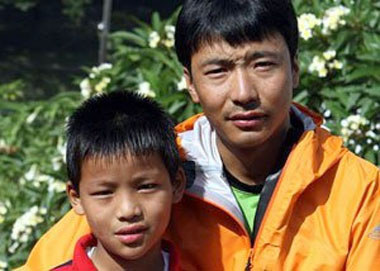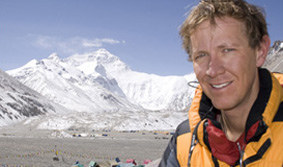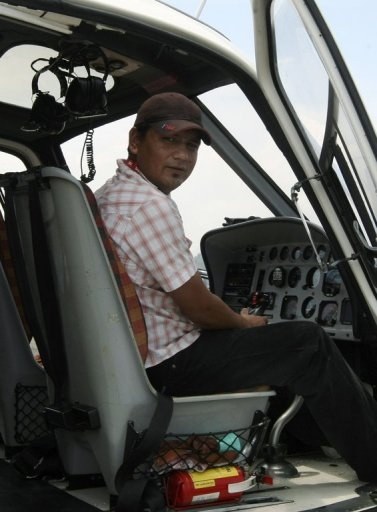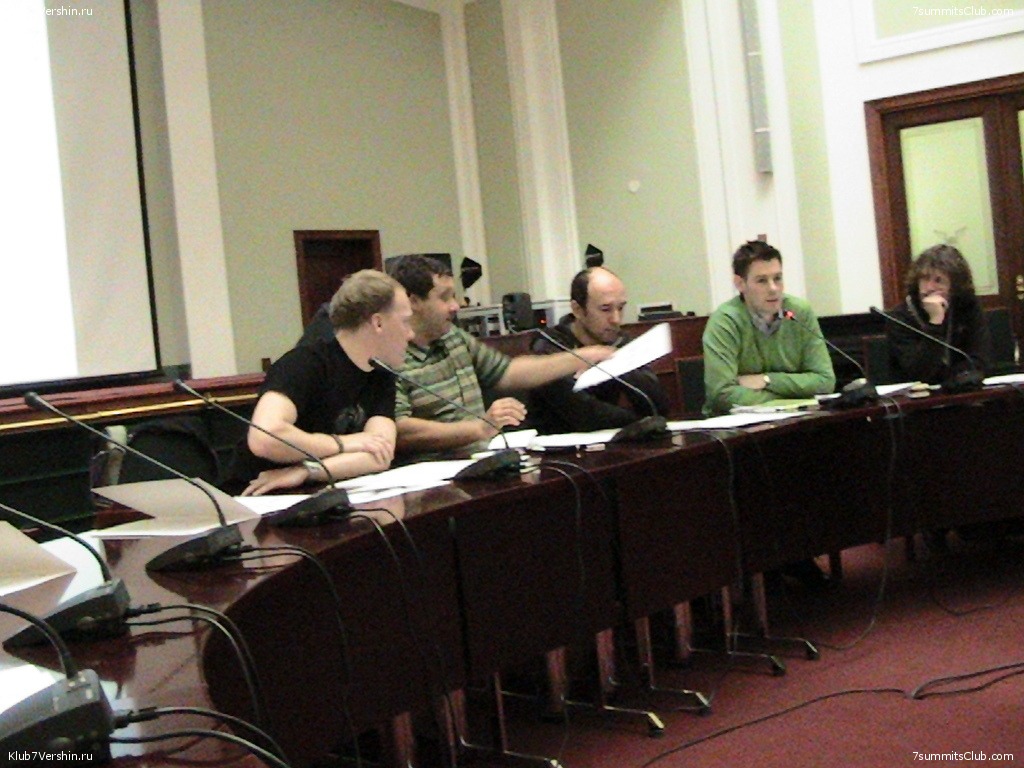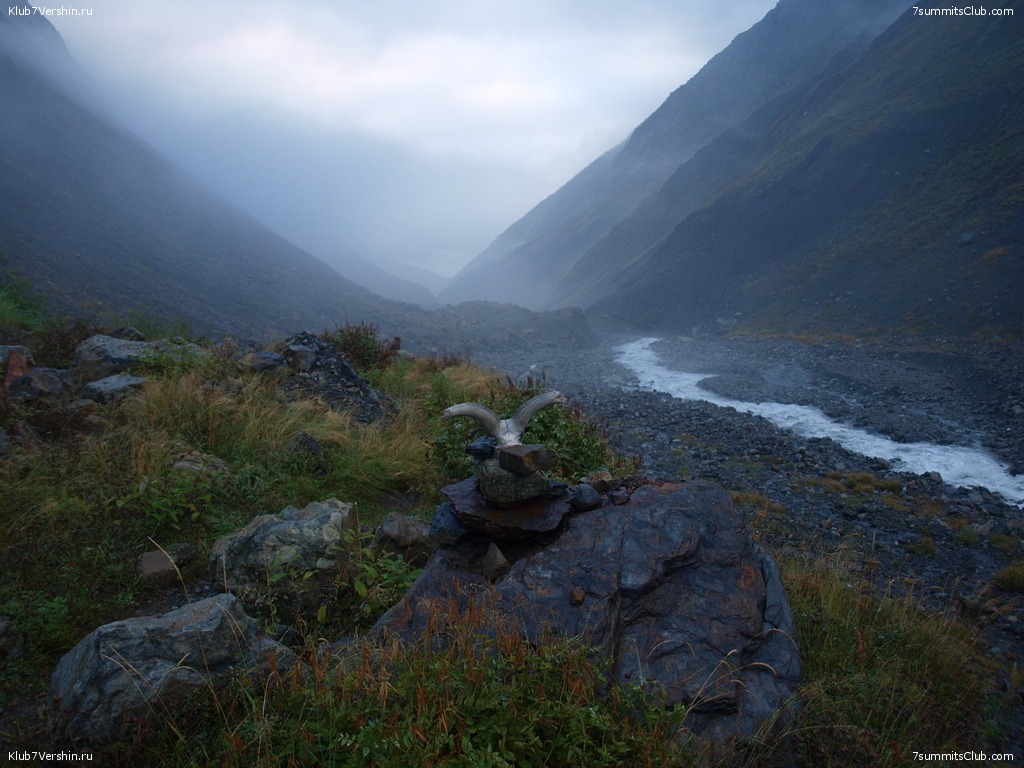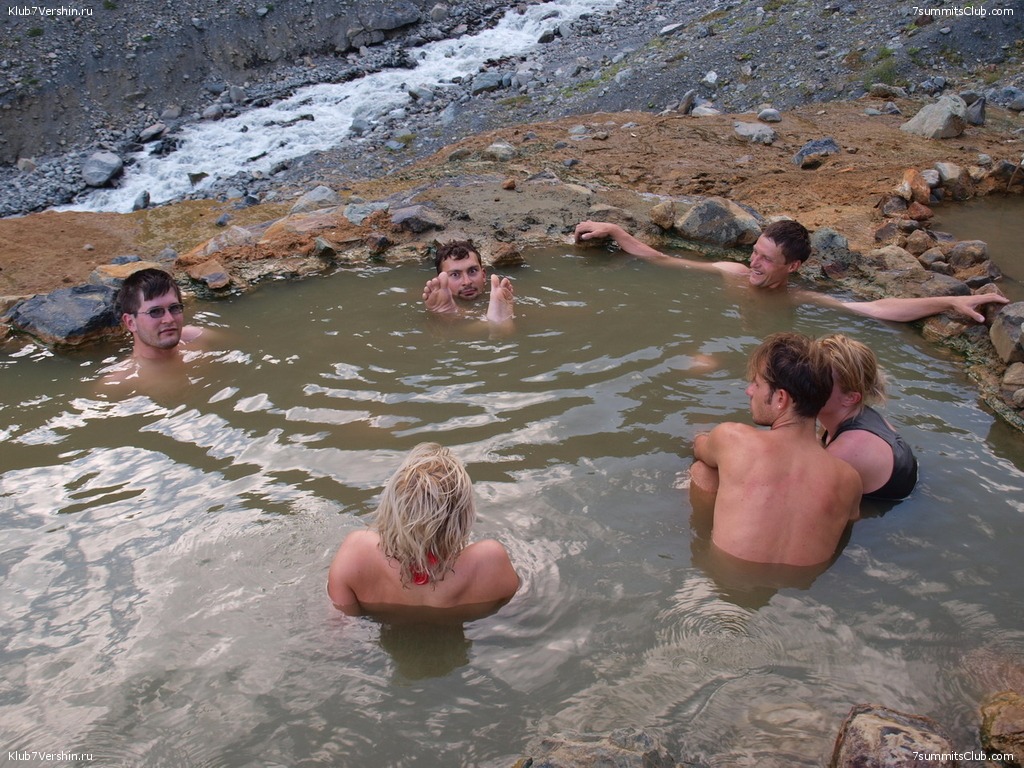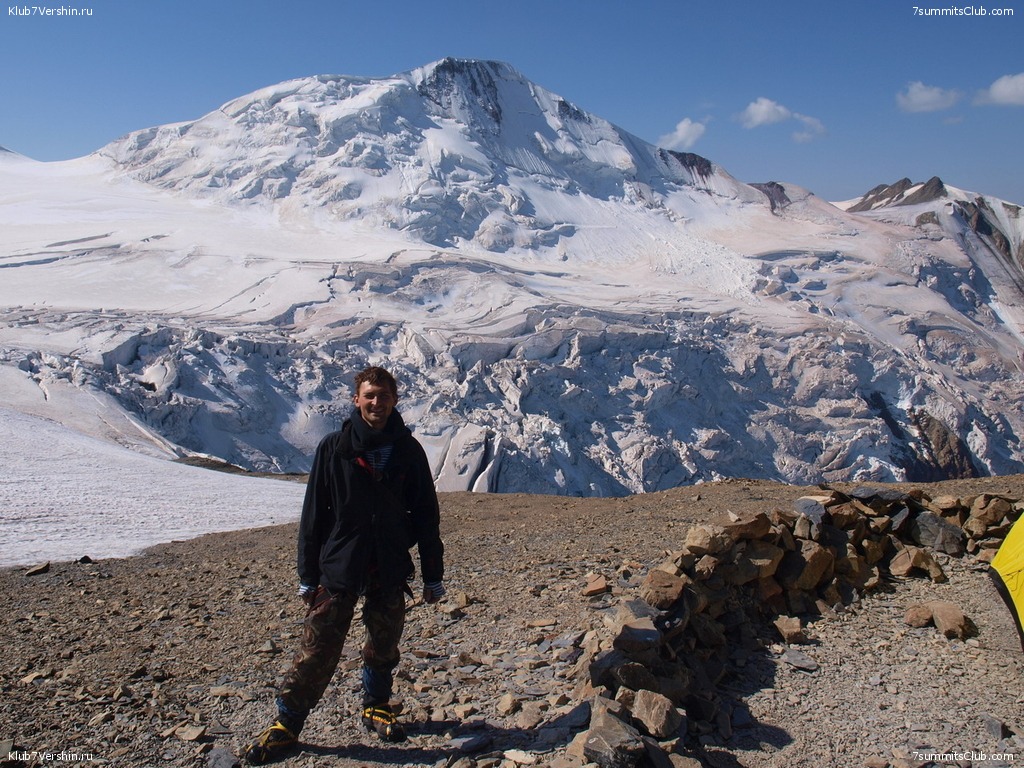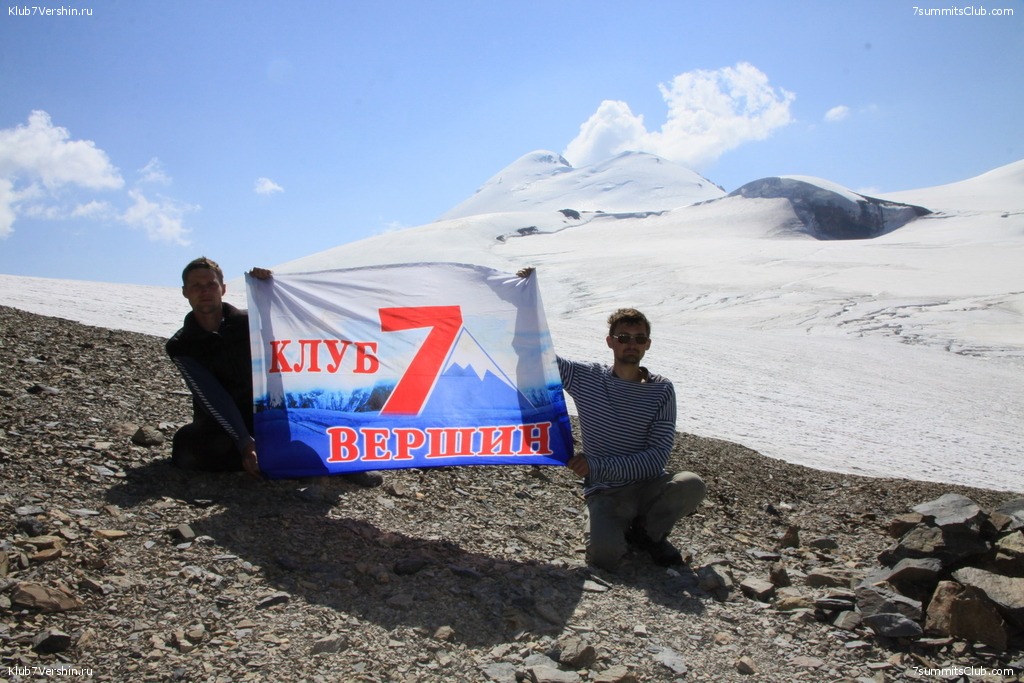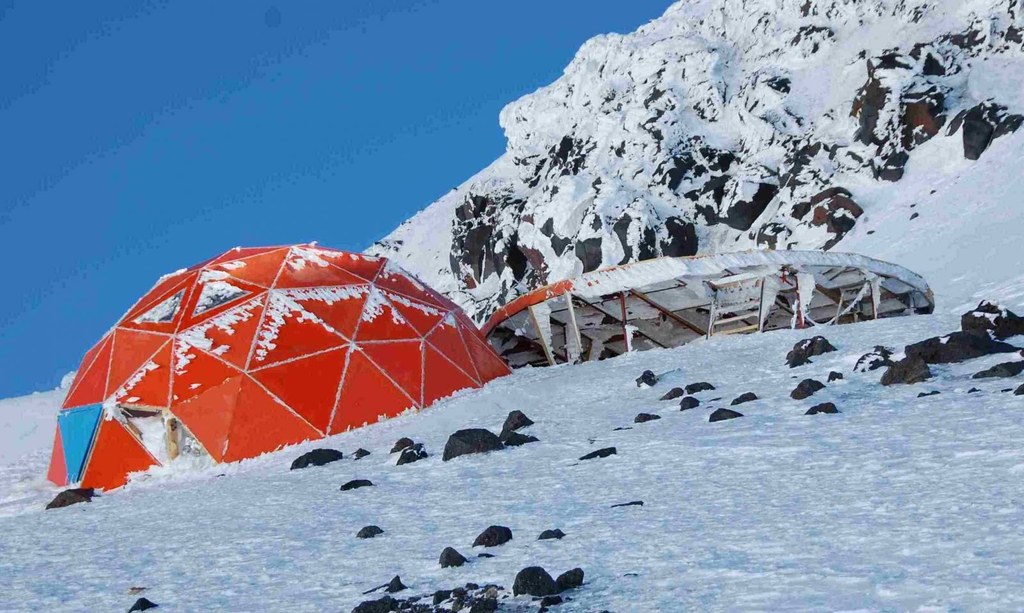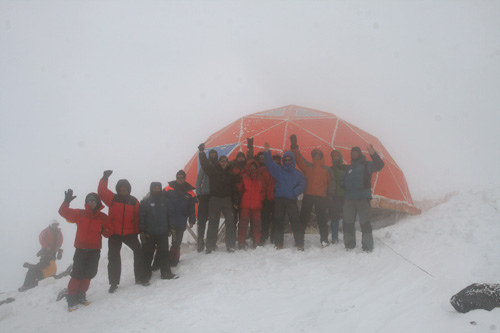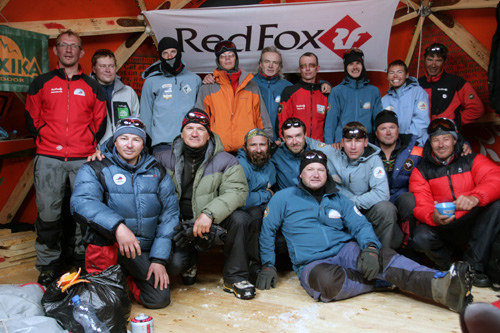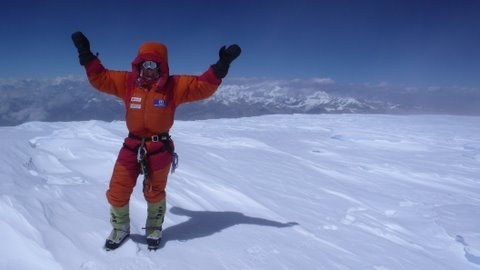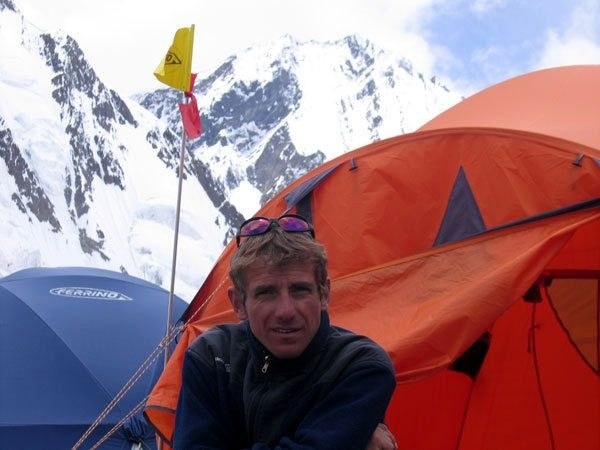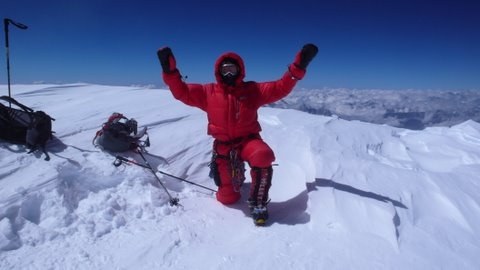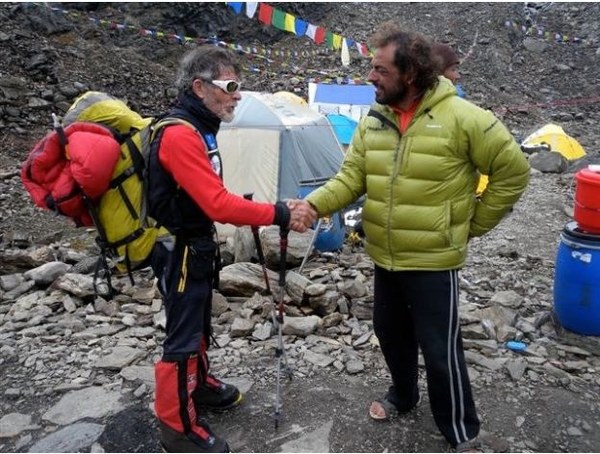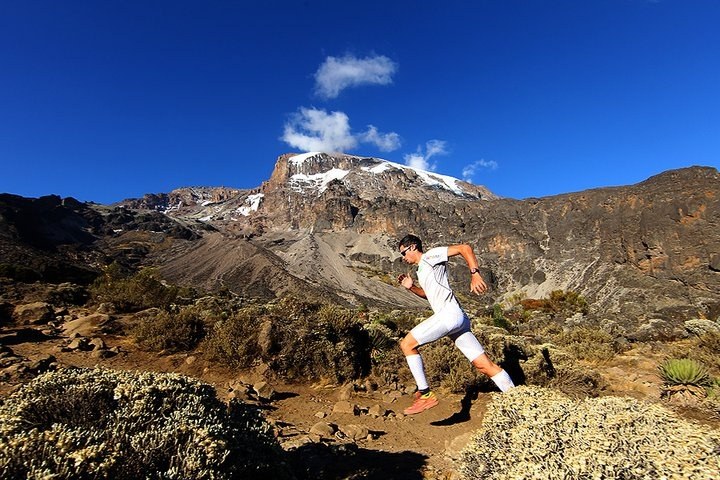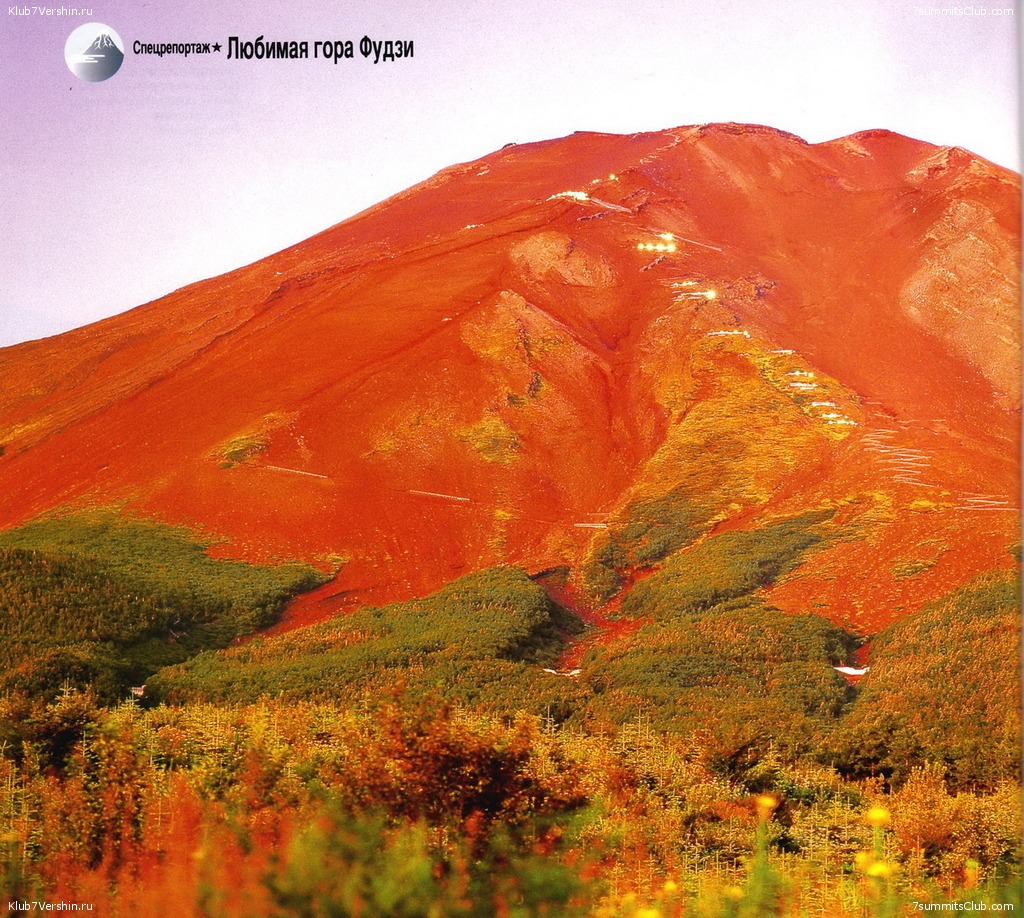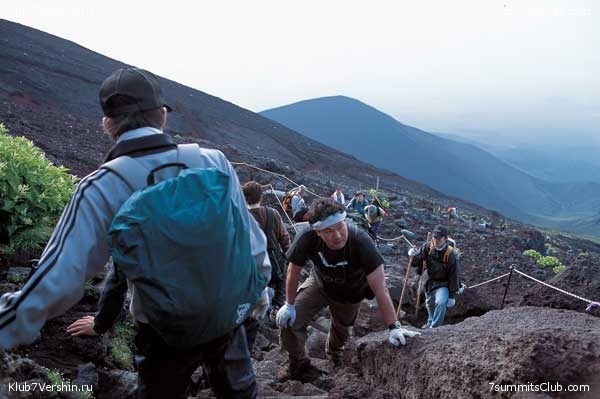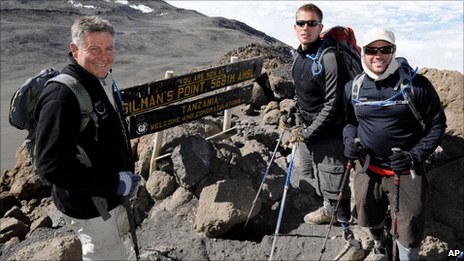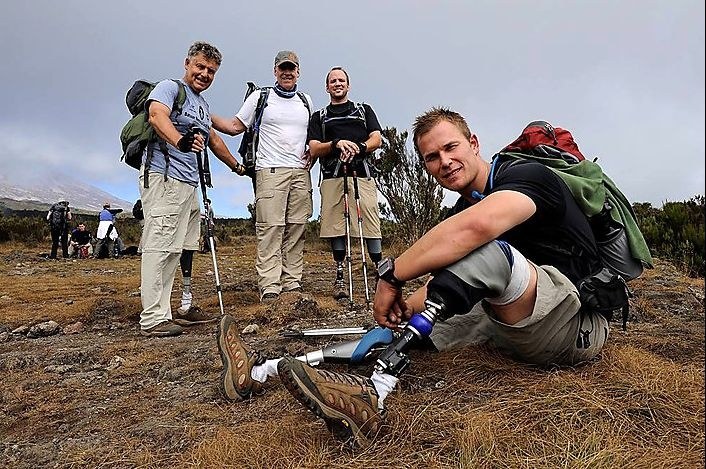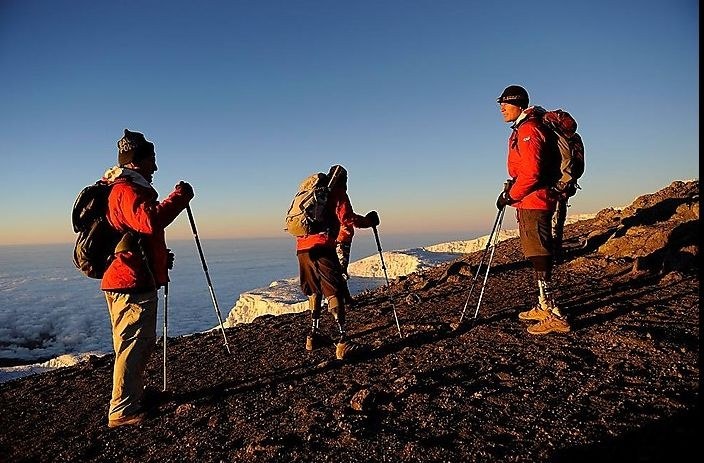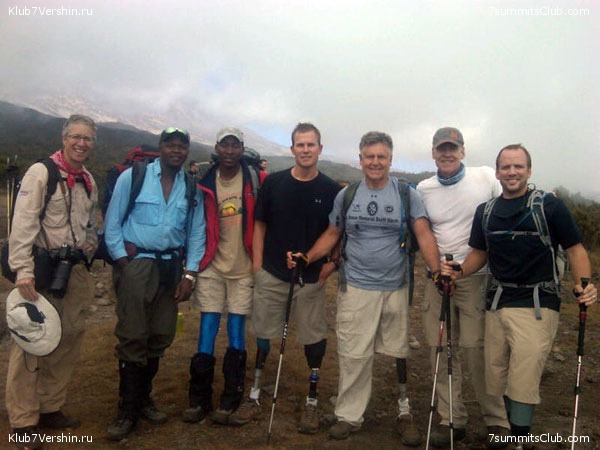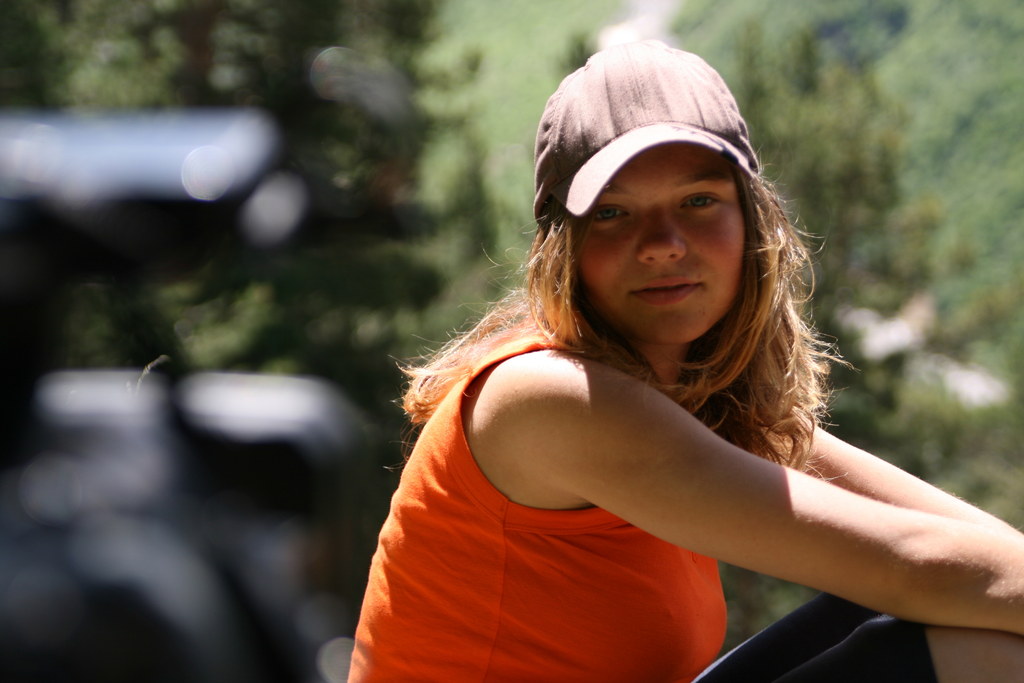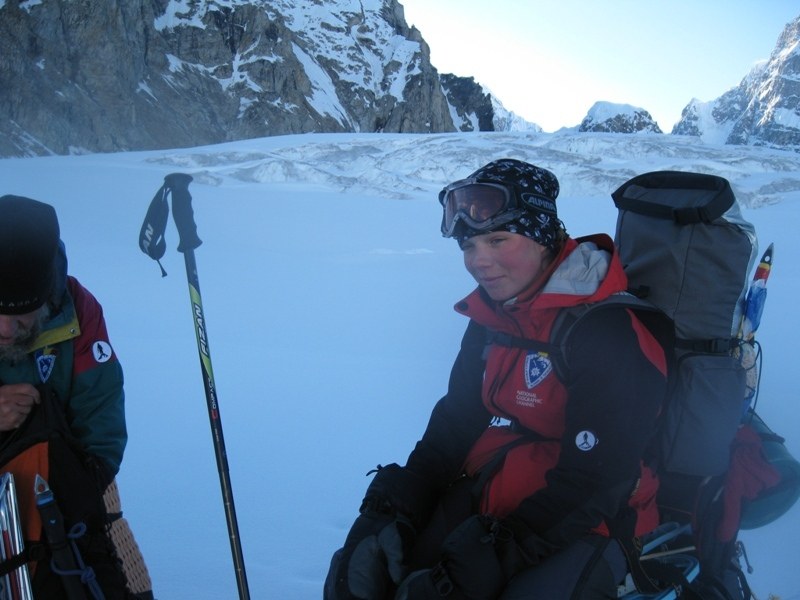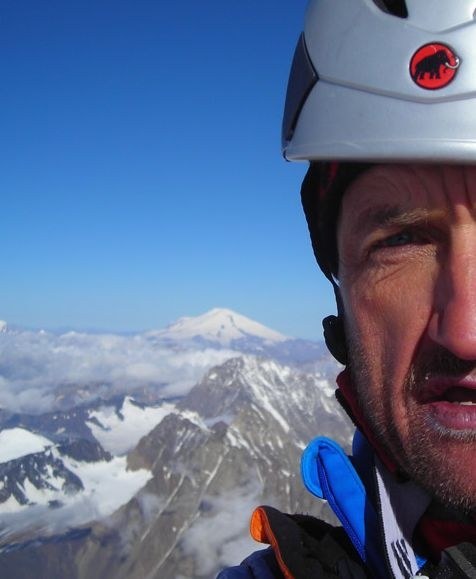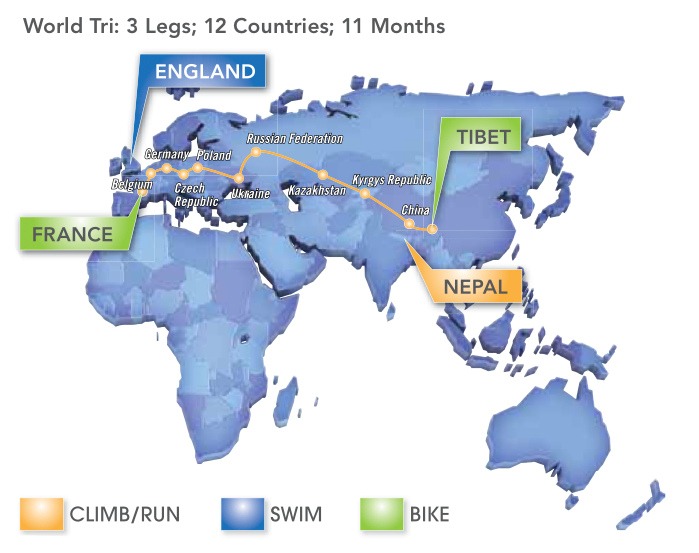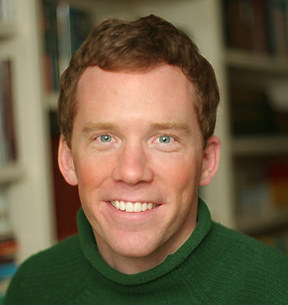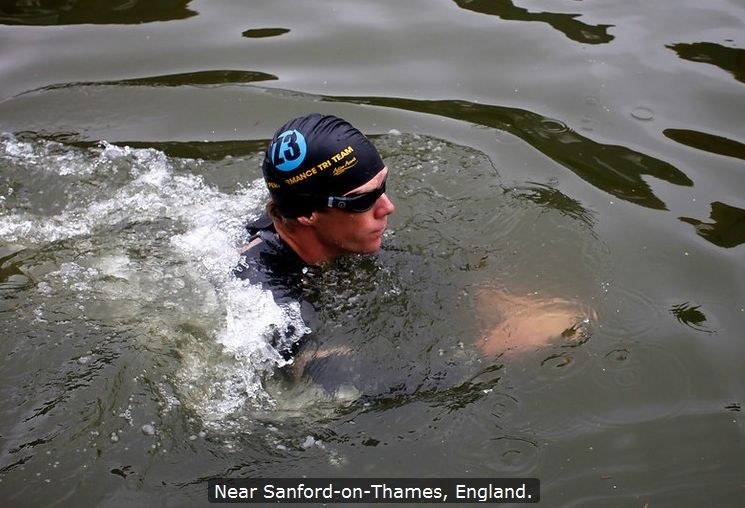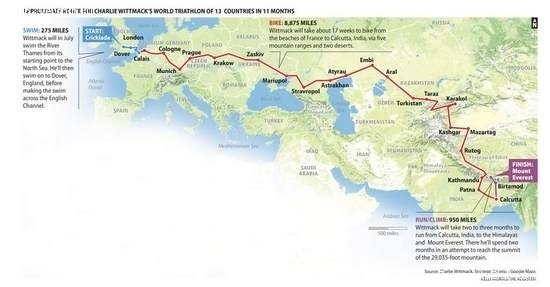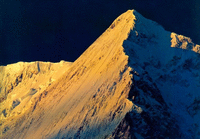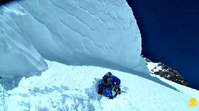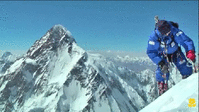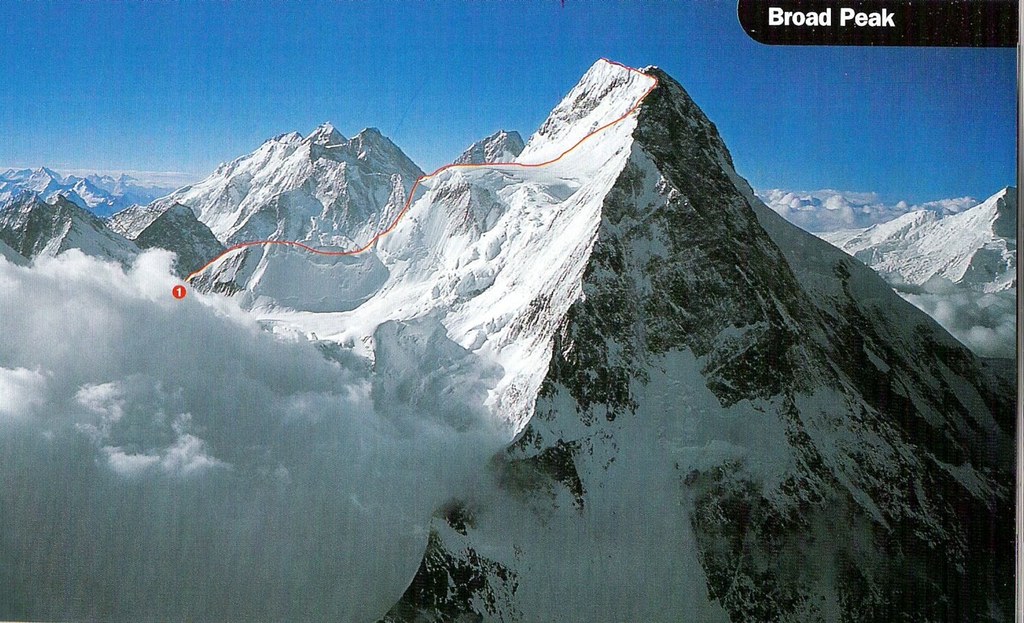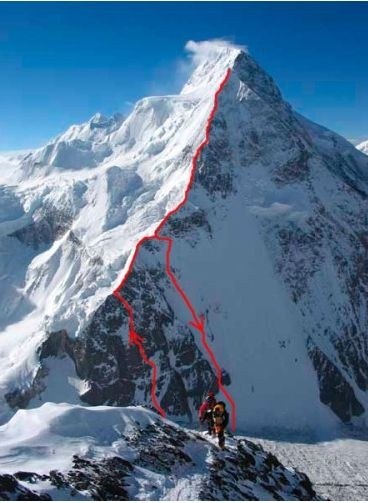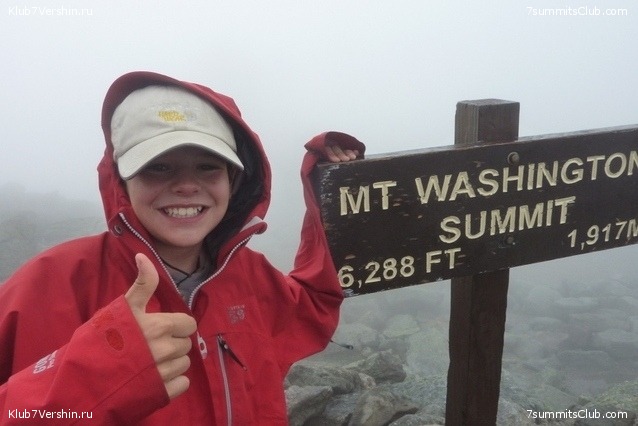World mountain's news
9-year-old to climb Mount Everest and more news
Everest.
(CNN) -- This year a 13-year-old from California stunned the world when he became the youngest person to summit Mount Everest. Now a 9-year-old Nepalese boy says he can do it, too. Or at least that's what the child's father is reportedly ...
(CNN) -- This year a 13-year-old from California stunned the world when he became the youngest person to summit Mount Everest. Now a 9-year-old Nepalese boy says he can do it, too. Or at least that's what the child's father is reportedly promising.
Sherpa Pemba Dorje, who holds the world record for the fastest Everest ascent (8 hours, 10 minutes), recently boasted that his grade-schooler will try to conquer the globe's tallest mountain in 2011.
To illustrate his seriousness, Dorje and his son Tseten last week climbed Mount Ramdung, a 19,440-foot peak in the Dolakha region of Nepal, according to the Himalayan Times daily and the Indo-Asian News Service. Dorje told reporters it was a practice run for Everest, which is more than 29,000 feet.
The notion of another baby-faced adventurer -- backed by an ambitious parent --sailing the widest seas or climbing the tallest mountain unearths a familiar question: Does inherently dangerous record-setting have an age limit?
"Little children do not belong on big mountains," said Jiban Ghimire, a Nepali renown for leading multiple expeditions on Everest. Ghimire's Shangri-La Treks & Expeditions, a go-to climbing assistance company, has employed Dorje as a guide. "I know Pemba Dorje, and I know he's said he wants his child to do this, that his son is capable of it.
"I would not want to discover, on that mountain, that the boy is not capable," Ghimire said. "I feel that you ask for something bad with this."
The obvious objections to allowing a child to climb Everest, or any major mountain, have to do with the physical toll it could take on his or her body. While there's no conclusive research that an adolescent is more susceptible to developing potentially fatal altitude sickness, anecdotes of mental and physical woe abound.
Past Everest climbers have experienced motor-skill dysfunction, sleep troubles, language disassociation and other problems that may be related to depriving the brain of oxygen while climbing, experts say.
Alan Arnette, a Colorado-based climber, has been on 20 expeditions from Tibet to Argentina. He most recently climbed 27,500 feet up Everest.
"Nobody doubts how talented Sherpa Pemba is," Arnette said. "Any Westerner would be smart to trust their life with him on the mountain. But that's any adult."
"When you get up there, it's not like you're gasping for air, you feel like you want to sit down and sleep forever -- that's altitude sickness," he said. "You have to be aware of what your body is doing and act accordingly. That's an adult's experience. Who knows what would happen to a developing child."
Besides, Arnette surmises that the odds of the boy making it past base camp are "just about zero."
The China Tibet Mountaineering Association, which regulates expeditions in Tibet, issued new climbing rules this year that ban anyone younger than 18 from climbing the Tibet side of Everest. A climber must be 16 to attempt Everest from the Nepali side. Penalties for breaking the rules are stiff, ranging from high fines to prison.
Arnette points out that every expedition must have a permit, which can cost tens of thousands of dollars. It's relatively easy for Everest authorities to catch someone trying to climb illegally, he said. Permits must be shown to officials when entering the park, and liaison officers from the Nepal Ministry of Tourism are assigned to each expedition group to help in case something goes wrong, and to ensure groups aren't leaving behind garbage.
In Dorje's case, everyone on the mountain knows who he is. He's clearly drumming up publicity for the climb. So why? Is it money? Arnette doesn't think so.
"No company or sponsor is going to get behind this. There's too much risk," he said. "My best guess is that he's motivated by national pride."
In May American Jordan Romero, 13, became the youngest person to summit Everest.
"I think all the Everest records should be held by Nepalese people," Dorje told London's Daily Mail.
Jordan received worldwide press for his feat, most of it glowing, and he encouraged younger kids to follow in his bootsteps. "Age is not a matter," Jordan told reporters in Kathmandu a day after he returned from his climb, which took 10 months and 10 days. "My body did cope with the altitude very well."
The teenager broke a record few thought possible.
"The American boy is famous. When many people think of Everest, they say his name," Ghimire said. "But a mountain doesn't care who you are."
*************************************************************************
Adventurer Chessell hangs up his boots
Adelaide adventurer Duncan Chessell, a three-time conqueror of the world's highest mountain, has hung up his climbing boots and is planning to go prospecting for gold and uranium.
Chessell has joined newly formed company Endeavour Discoveries as its managing director and will take a break from leading expeditions to such places as the Himalayas or Antarctica for a few years.
"I have faced many challenges and overcome almost all of them by working with extraordinary teams of people on seven continents and have enjoyed almost every minute of it," Chessell said in an email to his clients and supporters on Monday.
"I have now reached a stage where I am over living from backpacks though.
"So thanks for coming along for the ride, sail, paddle, walk, climb - it has been simply awesome."
In May this year Chessell became the first Australian to reach the summit of Mt Everest three times in an expedition hampered in its final push by heavy snowfalls.
His triumph followed his two previous trips to the top of the world in 2001 and 2007.
Chessell has sold his Chessell Adventures company to friend and sales and office manager Katie Sarah. Sarah was part of the group that reached the Everest summit this year.
As the boss of Endeavour Discoveries Ltd, he plans to take the company to a public float in the next 12 to 18 months. "We are aiming to discover gold and uranium deposits in South Australia and the Northern Territory," he said.
**************************************************************************
Bad Weather Strands Thousands near Mt. Everest
Flights are still grounded at the air strip closest to Mt. Everest, stranding around 2,000 foreign tourists, including some Americans, in the small town of Lukla in eastern Nepal.
"Again the weather was very bad today," wrote Phurba Gyeljen Sherpa, proprietor The Irish Pub and Internet Caf?. "Very few airplanes were able to go out and the Americans here, and other nationalities, have grown weary and frustrated."
The military stepped in and posted flyers at the airport telling people not to pay more than $350 for private helicopter companies.
"Then they flew in large MI-17 military transport helicopters, cable of carrying 24 people each," continued Sherpa.
The military chose who would fly out first by who was stranded there the longest, instead of those willing to pay the most money.
Since there was only a brief period of good weather, the military quickly ferried the stranded people to a nearby airstrip in Ramechhap, where the weather was more stable.
When the weather destabilized, the military returned to Ramechhap and tourists to Kathmandu.
Slightly over 75 percent of westerners were evacuated.
******************************************************************
Will Wi-Fi ruin Mount Everest?
Broadband arrives on the world's tallest mountain. But having hiked it, I worry the magic will vanish
By Jeff Greenwald
When I began my career as a travel journalist in the 1980s, there was lots of talk about "remoteness." This was what many travelers were looking for: places so hard to get to, and so different from the world we knew, that their very existence seemed almost miraculous.
Today, the value has shifted. What we look for now is connectedness: the opportunity to check our e-mail, upload video clips and chat on Skype -- even if we happen to be on the Khumbu Icefall, 18,000 feet high in the Nepal Himalaya.
Last week, a network of eight 3G base stations began operating along the route to Mount Everest, in Sagarmatha National Park. They were installed by Ncell, a Nepali telecom firm. The news didn't surprise me. But I felt that, irreversibly, another blow had been struck against magic.
Access to the Internet is starting to seem like a human right, so let me offer a disclaimer. There is no rational downside to the arrival of broadband on the flanks of Everest. I'm not a Luddite, and would never suggest that developing nations should be denied, for any reason, the global access that technology can provide. This 3G network will undoubtedly save lives -- not only by providing weather information and support to Everest climbers and trekkers, but as an alert system for the nearby villages threatened by flash floods from Glacial Lake Overflow (GLOF), another peril caused by global warming.
It's a good thing. So why did the news make me feel like Robert Conway in "Lost Horizon," looking back on a land to which I can never return?
During my earliest visit to Nepal in 1979, phoning home even from Kathmandu was an adventure. I'd bike to the Telecommunications Office at 2 a.m. (mid-afternoon in New York), fill out a form, and wait hours for my trunk call to go through. The costly result was often a busy signal -- or a barely audible connection. The most reliable means of communication was "snail mail": a metaphor that, with three weeks of lag time between a letter and its response, seemed literally true.
Even this much contact was a marvel, compared to the situation in the mountains. When I first trekked the Everest route, in October 1983, it felt as though I'd entered a world completely detached from the familiar. After a harrowing flight to the tiny airstrip at Lukla, the 10-day hike to Base Camp (with an elevation gain of more than 8,000 vertical feet) began. Immersion in the Sherpa Buddhist lifestyle was inescapable, and transformative. Phone calls were impossible. Even writing a postcard was like putting a message in a bottle, and tossing it out to sea.
None of this seemed like an inconvenience. Though there were bouts of homesickness, and the occasional longing for new music and old friends, it was exhilarating to have entered such an isolated realm. This, actually, was the point. Travelers embarked on our journeys to Everest or the Annapurnas aware that it would be a full-body experience -- an equation that included our brains.
As a result, trekking in the Himalaya never felt like sightseeing. It was a commitment to the here and now, demanding full-time engagement with both Nepalis and fellow travelers. There were infinite opportunities to forge new friendships, experience Sherpa Buddhist culture, or enjoy exquisite solitude. By day, you could walk alone or with companions; at night, the lodges flickered with candles and butter lamps. Out came the maps, backgammon sets and tattered journals. Tales of avalanches and Yeti sightings were shared, along with cups of the dizzying local rakshi.
During my most recent trek to Everest region in 2008, it was clear that the area was changing. Though the mountains looked the same, they felt less like a world apart. For one thing, it was a lot more crowded; an estimated 15,000 trekkers shared the narrow trails. Cellphones were already in use between the main villages, and the isolating aspects of technology were taking hold. Sherpa guides and sinewy porters marched up the steep mountain grades with telltale white headphone cords snaking beneath their parka collars, lost in the private soundtracks of their MP3 files.
Getting online was a different story. There were only a handful of cybercafes along the trekking route -- the highest of which was at Everest Base Camp itself, at 17,500 feet -- with Internet access via satellite. Connections were sluggish; it often took Gmail more than five minutes to load. Sitting in a cozy inn, immersed in conversation, was far more seductive than surfing the Web.
The arrival of 3G will change all that -- and not just how quickly trekkers can upload their photos to Flickr, keep tabs on their investments, or stream the latest episode of "Mad Men." Wireless broadband, barely imaginable even 25 years ago, will change the way future travelers and locals interact in the world's highest mountains.
For the Sherpas of Sagarmatha, of course, it may well seem that one kind of magic has simply been traded for another. Broadband on Everest! What next? If the Yeti buys an iPad, he might even decide to "friend" Bigfoot on Facebook.
For the rest of us, this constant connectedness may have a bittersweet aftertaste. My recent trek into the Himalaya was a reminder of the pleasures of remoteness. It was a joy to escape from the hamster wheel of distractions, and immerse myself in the expanded moment of real time. Because being connected -- really connected, with the place you're in and the people you're with -- requires disconnecting, at least temporarily, from everywhere else.
We are far past the time when we can expect to a find a Shangri-la, anywhere, beyond the reach of the Internet. But as the world races toward connectivity, travelers might stop to consider why we travel in the first place, and which connections we really want to make.
Autumn 2010, summary from Ang Tsering and Explorerweb
Nepal Expeditions - Autumn 2010 (Government Peaks): The following is the detail of the permits issued to expedition teams for 8000m Peaks by the Ministry of Tourism and Civil Aviation in this Autumn Season 2010: 2 Teams of 1 member each on ...
Nepal Expeditions - Autumn 2010 (Government Peaks):
The following is the detail of the permits issued to expedition teams for 8000m Peaks by the Ministry of Tourism and Civil Aviation in this Autumn Season 2010:
2 Teams of 1 member each on Mt. Everest (Nepal Side)
2 Teams with a total 6 members on Mt. Lhotse
8 Teams with a total of 86 members on Mt. Manaslu
2 teams with total of 9 members Mt. Dhaulagiri from Nepal Himalayas
The above figures do not include the number of high altitude Sherpa (HAS) climbers.
Tibet Expeditions - Autumn 2010:
The following are the teams permitted on 8000m Peaks in Tibet:
2 Teams with a total of 12 climbers on Mt. Everest (including HAS)
25 Teams with a total of 340 climbers on Mt. Cho-oyu (including HAS)
3 Teams with a total of 45 climbers on Mt. Shishapangma(including HAS)
Death and Casualties:
Mt. Dhaulagiri (8167m):
An avalanche on Mt. Dhaulagiri killed three Japanese climbers, Osumu Tanabe(49 yrs),Toshio Yamamoto(36 yrs) and Daisuke Honda(32 yrs) and a Nepalese Guide Pasang Geylu Sherpa on 28th September.
Mt. Cho-Oyu (8201m):
The leader of the Cho-Oyu South West Face Expedition 2010, Walter Nones(39 yrs) of Italy had a fatal fall on 3rd October and died while climbing Mt. Cho-Oyu from South West Face New Route.
Mt. Manaslu (8163m) Base Camp:
Mr. Nobuaki Kuwabara(61 yrs) of Japan diet at the Base Camp of Manaslu on 24 September 2010. He was member of "Adventure Guides Mt. Manaslu Exp.2010" under the Leadership of Mr. Kenji Kondo of Japan.
We pray that may all the departed souls rest in peace and express our condolence to their family members and friends.
UIAA General Assembly Highlight:
The UIAA General Assembly which was held from 6th-9th October in Bormio was very fruitful. The outcome of the assembly is beneficial to all the members of UIAA. It focused on the necessity of the Expedition Commission to be re-activated. On the sidelines of the 2010 UIAA General Assembly, leading members of the global climbing community discussed the concerns of climbers and challenges of undertaking expeditions to high and remote mountain ranges.
The next general assembly of UIAA will be held on 5th to 8th October 2011 and the general assembly of UAAA will be held on 9th October 2011. Both the events will be hosted by Nepal in Kathmandu. Since the same year Nepal is celebrating Nepal Tourism Year 2011, I hope that both the events will be instrumental in promoting Nepal Tourism Year 2011 to make it a great success, as well as bringing many benefits to the mountaineering community.
Summit of Manaslu
Explorerweb
October 15 at 12:30 PM Eric Larsen plus Sherpas Dawa Gylatzen, Tshering (Chhering) Dorje, Pasang Temba and Dawa Tenzing bagged the first Everest fall season summit in four years. The Terramar sponsored expedition concluded Larsen’s quest to reach the “Three Poles” in record time.
Serial Everest summiteer lost on Baruntse The loss of Chhewang Nima Sherpa put a sad end to the climbing autumn season, wrapped up in a special report by Ang Tshering Sherpa. 19x Everest summiter Chhewang Nima Sherpa was caught in an avalanche while fixing ropes on Baruntse upper sections.
Marty Schmidt’s “shortest Himalaya expedition ever” Marty cut his solo 4-day Lhotse attempt short in order to guide a client on Ama Dablam.
Jordises out of Lhotse Spanish “K2 pirates” Corominas and Tosas finally threw in the towel on Lhotse, due to dangerous conditions.
Shisha Pangma South Koreans Chang-Ho Kim, 41, and Sung-Ho Suh summited Shisha Pangma at 2:15PM on October 14, after climbing the British route on the peak’s south side. Chang-Ho Kim claims Shisha as his twelfth 8000er without supplementary O2; Sung-Ho Kim his tenth.
Cho Oyu summit mysteries German Ralf Arnold told ExplorersWeb he was the first Cho Oyu summiteer of the season, topping out October 1, 2010 at 10:30AM in a 15 hours roundtrip from C2. An October 7 Cho Oyu summit claimed by Argentinean Adrian Sanchez was questioned after the alleged summit picture turned out shot in C1 by expedition mate Marcelo Hernandez.
Dhaulagiri Search parties found the body of Daisuke Honda, one of the four climbers swept by an avalanche, buried in snow at about 5,000 meters on Dhaula.
Manaslu Together with a Japanese climber and his two Sherpas, Mexican couple Badía Bonilla and Mauricio López reached Manaslu summit sans O2 at 2:40PM, local time on October 1, some time after the HiMex and Carlos Pauner’s groups. “We were the last to summit that day,” Badia debriefed back in Kathmandu.
Blind Everest summiteer Erik Weihenmayer led a team of war-battered soldiers to the top of the 20,075-foot Lobuche on October 13.
Putha Hiunchuli (7,246m) was topped out on October 8 by Dutch Dick Valk, Kaji Sherpa and expedition leader Paul Boslooper.
Very sad news: the main rescuer of Nepal is dead
KATHMANDU: On a day of double celebration in Nepal -- Bhai Tika or Brother's Day, and the start of the Newari new year 1131 – tragedy struck in the Himalayan ranges in the north as a helicopter rescue operation for two Japanese ...
KATHMANDU: On a day of double celebration in Nepal -- Bhai Tika or Brother's Day, and the start of the Newari new year 1131 – tragedy struck in the Himalayan ranges in the north as a helicopter rescue operation for two Japanese climbers ended in a crash at 6000m above sea level, killing both the pilot and his companion.
While Nepal was celebrating its four-day Tihar holiday, Nepali pilot Sabin Basnet and technician Purna Awale were scouring the upper ranges of Mt Ama Dablam – meaning mother's necklace – a Himalayan range whose main peak juts up to 6812m above sea level. They had been sent by domestic airline Fishtail Air to airlift two Japanese climbers who had fallen ill.
After successfully rescuing the first climber, the two men went back for the second when high winds buffeted the aircraft and caused it to crash while trying to land. Two other helicopters sent to locate the missing chopper and its crew had to search the area for hours before they could locate the wreck and the bodies. Fishtail officials said they have now started the difficult operation of bringing the bodies down from the inaccessible mountain range.
This is the second air accident since August that resulted in casualties. In August, an aircraft crashed near Kathmandu valley, killing all 14 people on board, including a Japanese tourist. Last month, three Japanese climbers and their Nepali guide were swept away by an avalanche while climbing Mt Dhaulagiri, the seventh highest peak in the world.
The best high-altitude pilot, a real pioneer of rescue above 7000 m - Sabin Basnet
With swiss team after Lantang flight to find Tomas Humar
After epic Dhaulagiri rescue withh his swiss teachers
Seven Summits of the Moon: The Highest Point is found…
Everest.
Over the course of the Lunar Reconnaissance Orbiter mission, the LOLA team has diligently watched as the highest point on the Moon got higher and higher. No, the Moon is not expanding, but rather the LOLA profile coverage increases each ...
Over the course of the Lunar Reconnaissance Orbiter mission, the LOLA team has diligently watched as the highest point on the Moon got higher and higher. No, the Moon is not expanding, but rather the LOLA profile coverage increases each month so the chances increase that a ground track will pass directly over, or very near to the highest point. The highest point on the Earth is at the summit of Mount Everest, which is 8,848 meters (29,029 feet) above sea level. The lunar high point is 1938 meters higher than that of the Earth ! However there are several major differences between the two points. Mt Everest is a relatively new feature on the Earth.
It was formed as tectonic plates collided and pushed up to astonishing heights what was once seafloor, over the course of about 60 million years. The lunar high point is very ancient, and was possibly formed as ejecta from the enormous South Pole Aitken basin piled up during this cataclysmic event, in a matter of minutes, more than 4 billion years ago. Another key difference between the two highest points is slope. The flanks of Mt Everest are very steep, while on the Moon the approach to the summit has slopes of only about 3°, assuming you skirt around impact craters.
According to Mark Robinson, chief of the Lunar Reconnaissance Orbiter (LRO) camera team the lunar high point is 10786 meters high!
The selenean summit was identified using an instrument known as the Lunar Orbiter Laser Altimeter (LOLA) also mounted on the moon-circling LRO satellite. As the LRO sweeps along just 30 miles above the lunar surface (it can orbit so low due to the lack of any atmosphere) the LOLA laser generates a record of the peaks and troughs beneath.
Once the LOLA had identified the lunar highpoint's general vicinity, an allied team of boffins in charge of the spacecraft's camera took over for the final precision fix.
Once the LOLA team had the spot narrowed down to a small area, the LROC team commanded a NAC stereo pair (12 August 2010) to get an even higher resolution measurement of the elevation and coordinates of the highest point. Once the stereo pair was on the ground, the LROC team processed the images into a digital elevation model (DEM), or topographic map.
Though it is actually higher than the peak of Mount Everest, as the photo shows the moon's topmost spot is far less dramatic - more in the nature of a high plain or plateau, with the ground sloping away around it at no more than 3° according to Robinson (apart from impact craters). It lies near the Engel'gardt crater on the fringe of the Korolev plain, on the lunar far side. Robinson considers that it was probably formed by ejecta - molten rock - piled up during the cataclysmic South Pole-Aitken meteor impact over four billion years ago.
The LRO was launched back when NASA was still expecting to send humans back to the Moon in the near future, and perhaps to establish permanent inhabited bases there. Thus it was of the first importance to thoroughly map the surface, in order to avoid hairy landings into the unknown like those made by the early Apollo astronauts.
Though President Obama has now decreed that there will be no return to the Moon, the LRO has still made many interesting discoveries
Round table "Russian Mountain Guides – formation of professional community" ...
Everest.
"Round Table. Russia mountain guides - becoming a professional community "was held on 29 October as part of the exhibition "International Ski Salon”. It was an informal meeting of members of the Association of Mountain Guides of ...
 "Round Table. Russia mountain guides - becoming a professional community "was held on 29 October as part of the exhibition "International Ski Salon”. It was an informal meeting of members of the Association of Mountain Guides of Russia, a report of committee and discussions of some details of its work. one of the chairmen of the organizing committee of the Association of Mountain Guides of Russia Sergei Zon-Zam introduced Russia Officer Russian Mountaineering Federation (RMF) Roman Bryk for a report.
"Round Table. Russia mountain guides - becoming a professional community "was held on 29 October as part of the exhibition "International Ski Salon”. It was an informal meeting of members of the Association of Mountain Guides of Russia, a report of committee and discussions of some details of its work. one of the chairmen of the organizing committee of the Association of Mountain Guides of Russia Sergei Zon-Zam introduced Russia Officer Russian Mountaineering Federation (RMF) Roman Bryk for a report.
Post Roman was quite brief. The Work is proceeding and is now in the stage of signing contracts with partner organizations. The choice is approved in favor of "Canadian" model, with separation of the ski and climbing blocks. Fedor Farberov is working on programming. Partners RMF for the School of guides to determine for 2011. In the near future site of the Association of guides should start working.
Maxim Balakhovsky made on submission of the draft Etique Code was made by a mountain guide. Actually, he just read it with little commentary. In developing the basis for the Code is taken code UIAGM. This part of the Round Table program caused the most lively discussion ..
The second chairman Nicholay Veselovsky, Director of "Vertical World Co made an announcement for 2011: Schematic diagram of the Russian national school of mountain guides, modules for 2011 and school partners. Next year, two units of the School will be held in June and one general unit will be held in December.
Partners: Gore-Tex, Red Fox, Pieps, Petzl,
Leading the seminar stressed that for the first issue of school guides, they are going to possibility to take part for future teachers of the school guides. The process of recognizing the future diploma by UIAGM structures will be very long and we have to start it, even if not completely ready.
Ossetian authorities decided to erect on the route to Kazbek three mountain huts
Elbrus.
Now a new state tourism development program in the North Caucasus aimed at construction of Olympic facilities in Krasnaya Polyana. However, all republics of this region have their own plans for development of mountain infrastructure. So in ...
Now a new state tourism development program in the North Caucasus aimed at construction of Olympic facilities in Krasnaya Polyana. However, all republics of this region have their own plans for development of mountain infrastructure. So in North Ossetia, a work on construction of a large resort in the area Mamison pass already began. In addition, the river valley Genaldon is the focus of the authorities, through which the route goes to one of the most famous mountains of the Caucasus – Kazbek (5033m). In this year's there was a regular annual International alpiniada from 4 to 13 September. About 200 people from Russia and CIS countries have climbed to the top of Kazbek. But now the route is still without a single mountain huts, all nights are in tents.
 Chairman of the Republican Committee on Tourism, Oleg Karsanov stated that the Committee has developed a plan to build on the route to the summit of Kazbek on the northwestern slope of the glacier Mayli three mountain huts: at elevations 2,300 m, 3450 m, 4149 m.
Chairman of the Republican Committee on Tourism, Oleg Karsanov stated that the Committee has developed a plan to build on the route to the summit of Kazbek on the northwestern slope of the glacier Mayli three mountain huts: at elevations 2,300 m, 3450 m, 4149 m.
The highway to the village Tmenikau will be reconstructed and extended further up to the level of 1950 m (sandy river of Genaldon). Wide footpath will be laid to the upper hot Karmadon springs (2300m), where it will be built a largest hut. In this area there are great opportunities for trekking and easy climbing. Except in the Kazbek district has a number of beautiful mountains: Dzhimarai-Hoch, Miley-Hoch, Shaukudza, Dzarasova Peak (Peak Polyakov), Pastukhova Peak, Peak Surveyor.
A traditional route to Kazbek from Russian (Ossetian) side
Genaldon Valley
Karmadon hot springs
To the summit of Kazbek
What happened to the hut on the saddle of Elbrus?
Elbrus.
Construction of rescue hut on the saddle of Elbrus carried out almost three years. Mountaineering Federation of Russia supported an initiative of some climbers, there were found money and volunteers for the work. Grand opening of the hut ...
Construction of rescue hut on the saddle of Elbrus carried out almost three years. Mountaineering Federation of Russia supported an initiative of some climbers, there were found money and volunteers for the work. Grand opening of the hut was on Sept. 1 2010, at an altitude of 5,300 meters. In September, Alexander Abramov, lead a group climbing Elbrus, had organized rescue work for a Polish climber. Hard to say, could this be done without the hut.
However, in late October, guide Eugene Kruten, climbing on Mount Elbrus, found that the refuge is destroyed. Upper part of hut is separated from the base and lying quite near but aside. This fact has caused surprise and intense discussion of what happened. In principle, the general conclusion is: it must be restored. Reason of destroying: changes in design, connected with the loss of some details during winter storage. Wind on the saddle has hurricane strength, quite often. We need more precise engineering calculation.
Two photos from Eugene Kruten
Rescue work at the hut
1th September, opening
Alan Arnette: Himalayan Successes of Different Types
Everest.
Climbing Himalayan mountains in the Fall can be risky at best. Each day is shorter, it is progressively colder and winter looms. So every summit, especially Everest, is highly valued by the climbers. This year, Fall 2010, we saw two summit ...
Climbing Himalayan mountains in the Fall can be risky at best. Each day is shorter, it is progressively colder and winter looms. So every summit, especially Everest, is highly valued by the climbers. This year, Fall 2010, we saw two summit successes of very different types.
First up is the only Fall Everest summit since the Fall of 2008. Eric Larsen and his small Sherpa team summited Everest at around 6:35 AM local time on October 15th. They broke trail and fixed their own ropes on the way to the top. Eric reported in an emotional audio post from the summit that they summited . He later reported they threaded the needle of a tiny weather window descending in white-out conditions to the South Col. He promised more details upon return to Base Camp.
His outfitter, Himalayan Trailbalzer listed the Sherpa team as: Mr. Tshering Sherpa, Pasang Temba Sherpa, Mr. Nima Dorje Tamang, Nima Dorje Tamang, Dawa Gelzen Sherpa, Pasang Dawa Sherpa and Da Tenji Sherpa.
There had been other teams on both the north and south but all abandoned plans throughout the season. Dangerous snow conditions were the culprit on the north side and running out of time was cited on the south. But Eric, wanting to complete a year long goal to ski to both poles and summit Everest on behalf of his "Save the Poles" mission persevered. Eric's stated goal:
"This expedition will tell the story of these remote places so we can better understand how our actions affect the poles and ultimately the planet," Larsen says. "We all need to be reminded that we must act now to stop global warming."
Please visit his website for more details. Congratulations Eric!
Another impressive summit was the Soldiers to the Summit team lead by Everest summiter and blind climber Eric Weihenmayer. They put 8 soldiers on the summit of Lobuche, 20,075′, which is often used for acclimatization for Everest climbs. From their site, Soldiers to the Summit: The goal of the Expedition and World TEAM Sports is to demonstrate to everyone that great things can be achieved no matter how high the obstacles.
From the team website:
We did it! On October 13th, eight of our injured soldiers reached the 20,075-foot summit of Lobuche. These men and women overcame their injuries, gave it their all, and achieved a great victory—not only for themselves but for other veterans, disabled people, and all of our sponsors.
We set out from high camp at 17,000 feet in two teams. The first team—consisting of Brad Bull, Steve Baskis, Sherman Bull, myself, Jeff Evans, Kami Tenzing, Ashley Crandall, Michael Brown, Rex Pemberton, and Didrik Johnck—left at 1:15 AM; Ashley felt the altitude and turned back. The second team—Charley Mace, Matt Nyman, Matt Murray Luis Benitez, Ike Isaacson, Dan Sidles, Kevin Cherilla, Chris Morris, Nico Moroulis, Chad Jukes, Chad Butrick, Brian Mockenhaupt—left camp at 3 AM. Catherine Raggazino (Rizzo) also felt the altitude and stayed at camp and Cody Miranda elected to stay with her.
Congratulations to all these climbers. See the previous report on their expedition.
The fall season is not over with climbs on Pumori, Ama Dablam and a few other Himalayas mountains underway.
Climb On!
Alan
Arnette is a speaker, mountaineer and Alzheimer's Advocate. He is climbing the 7 Summits starting with Mt. Vinson in November 2010 to raise $1 million for Alzheimer's research. You can read more on his site.
Mount Everest is singing for joy. Everyone else is worried
The Economist Magazine “MOUNT EVEREST is singing for joy and the Brahmaputra River swirling with happiness”. Or so says an official Chinese newspaper (using the Tibetan names, Qomolangma and the Yarlung Tsangpo). After much ...
The Economist Magazine
“MOUNT EVEREST is singing for joy and the Brahmaputra River swirling with happiness”. Or so says an official Chinese newspaper (using the Tibetan names, Qomolangma and the Yarlung Tsangpo). After much delay, China has started to extend its controversial railway line in Tibet that will draw more tourists to the mountain and boost trade with South Asia. How happy the outcome will be is not so clear.
Planning for the 253km (157-mile) line from the Tibetan capital, Lhasa, to the region’s second city, Shigatse, began in 2002, four years before Lhasa itself was connected to China’s railway network. The authorities appear not have been deterred by the problems that the railway brought to Lhasa. A tourism boom and a flood of immigrants from China’s interior contributed to an explosion of unrest among embittered Tibetans in March 2008. The launch ceremony in Lhasa of the $2 billion extension on September 26th was celebrated by dancing children in elaborate Tibetan costumes. Chinese television said the line would be of “great significance for the strengthening of ethnic unity”.
Like the route to Lhasa, which crossed the highest terrain of any railway in the world, the single-track extension will involve considerable technical difficulties. Nearly half of it will go through tunnels or over bridges (96 of them). It will cross areas prone to earthquakes, landslides and sand storms. Whereas the line to Lhasa had to traverse unstable permafrost, the new one will be challenged by geothermal fields with hot springs. All this at an oxygen-starved altitude of 3,550-4,000 metres.
The railway will make it easier to reach Mount Everest, which can expect to see a lot more tourists eager to be photographed in front of the world’s highest peak (Shigatse is also due to open an airport soon, Tibet’s fifth for civilian use). In 2007 the Chinese side of the mountain recorded 27,476 visits by Chinese tourists, almost twice as many as in 2006, after the new rail service to Lhasa had opened. Environmentalists are worried.
Shadows over Qomolangma
So are the Indians. The government in Delhi has been nervously watching China’s build-up of infrastructure in Tibet. The extension to Shigatse, besides facilitating military movements near China’s border with India, is likely to boost trade with Nepal, where the two giants are vying for influence in a power struggle that is still going on. China has long-term plans for more extensions of the line, to Nyalam on the border with Nepal and to Dromo near Bhutan and the Indian state of Sikkim. Nepal wants the railway extended to Kathmandu, which India fears would give China more clout in a country India sees as part of its sphere of influence. Another proposed line, from Lhasa east to Nyingchi, would bring the network close to the Indian state of Arunachal Pradesh, most of which China claims.
Tibetans might have mixed feelings too. The rail link to Lhasa brought disproportionate benefits to ethnic Han Chinese whose language and culture enabled them to take quicker advantage of the Han tourist influx. Tibet Business News said the majority of traders in Shigatse were migrants from beyond Tibet. It quoted a woman from neighbouring Sichuan Province saying that the railway would cut her costs of doing business in Shigatse by half. Expect more like her to come.
Correction: An earlier version of this article had it that “most of China” claims the Indian state of Arunachal Pradesh. Rather, (all of) China claims most of Arunachal Pradesh. This article was corrected on October 8th, 2010.
The Economist. Full text >>>>>>>
------------------------------------------------------------------------------
China official information
LHASA, Sept. 26 (Xinhua) -- China began work on Sunday to build an extension to the world's highest rail link, the Qinghai-Tibet Railway, linking Xigaze, the second largest city in the southwestern Tibet Autonomous Region.
The 253-km line from Tibet's capital Lhasa to Xigaze will pass through five counties as well as over the 90-km long Yarlung Zangbo Grand Canyon.
The work will take about four years.
This is the first extension of the Qinghai-Tibet Railway that opened in July 2006.
The Lhasa-Xigaze railway, with a budget of 13.3 billion yuan (1.95 billion U.S. dollars), is capable of transporting 8.3 million tonnes of cargo per year. The local authorities did not provide a projected annual passenger number.
Zhang Qingli, Communist Party chief of Tibet, said the rail line would make train services available in southwestern Tibetan regions which currently rely solely on roads for transport.
The railway will detour around nature reserves and drinking water sources and more measures will be taken during construction to better protect the fragile plateau environment, Zhang said.
Minister of Railways Liu Zhijun said the extension is a key project in China's long and medium-term railway network expansion and will speed up Tibet's social and economic development.
It will also play a vital role in boosting tourism and promoting the rational use of resources along the line, he said.
Further, Tibet is planning to build another railway to link Lhasa with Nyingchi to boost tourism and the economy in Tibet.
During its four-year operation, the Qinghai-Tibet Railway has reduced transportation costs and greatly boosted economic growth in Tibet, especially through developing tourism and other local special resources, Liu said.
Xigaze, with a history of more than 600 years, is Tibet's second largest city and the traditional seat of the Panchen Lamas.
Xigaze City is the administrative center of the Tibetan prefecture of the same name, a 182,000 square km area that borders India, Nepal and Bhutan. It is also famous for Qomolangma (known as Mount Everest in the West), which rises up from within it.
Our Cho Oyu Expedition continuie work and other news from the Himalayas ...
Everest.
At the beginning of last week there were doubts about the fact that someone even be able to climb Cho-Oyu. A significant part of expeditions turned their work. The head of our expedition (Ukraine - Himalaya 2010 + 7 Summits Club) Igor ...
At the beginning of last week there were doubts about the fact that someone even be able to climb Cho-Oyu. A significant part of expeditions turned their work. The head of our expedition (Ukraine - Himalaya 2010 + 7 Summits Club) Igor Svergun and Sirdar Mingma Gelu (7summits Adventure) also inclined to the idea of shutting down. However, after getting fairly good prognosis, as well as reports of the successful ascent of some German climber, they decided to continue the expedition. Tickets from Kathmandu were taken on October 16, so that you can still compete.
Manaslu
Hard season: the Himalayas against the climbers ... first autumn climbing and loss of ...
September 28 Japanese climbers from the team of the Association of Mountain Guides have got in an avalanche on the way from base camp to Camp 1 on the slope of Dhaulagiri. Mountain Guides Osamu Tanabe (49 years), Toshio Yamamoto (1936), Daisuke Honda (32) and Sherpa Pasang Gyelu Sherpa are died. Tanabe was the leader of Himalayan mountaineering in the country of the Rising Sun ". He has had 9 eight-thousanders, including Mount Everest in winter by south-west face, K2 and Makalu by a new routes.
Osamu Tanabe
Season on Manaslu is more successful. Although not without sacrifice. A Japanese mountaineer has died at the base camp.
Success of the Spaniards is in a focus. Carlos Pauner reached his 10th eight-thousander. And Carlos Soria, who turns 71 years old, went on the 9 th. This year veteran of the Spanish mountaineering completed the program of "Seven Summits", and plans "to make" 14X8000 before 2014
Soria and Pauner in the base camp
In the team of Himex a large group of climbers reached the summit of Manaslu on October 1. Russell Brice CEO (58 years) for the fourteenth time climbed peaks above 8,000 meters. True, 9 times it was Cho-Oyu. For Sirdar Phurba it was, by the way, 23th 8000 m peak (15 times Everest) and he became the leader among the Sherpas in this field.
Guides of Himex on the summit: Adrian, Russel and Marc
And the first of the season on top Manaslu was a leader of the expedition Dream Guides Kenton Cool. He led the team of three members and three sherpas. According to Kenton, tireless Dorjee Sherpa make almost all the way to the summit as first. From the summit of Manaslu Cool and one of the clients Andrew Eggleston went to the camp 4 on skis. It was September, 30th.
According to information from an expedition leader Fabrizio Zangrilli, 1th October, some German climber managed to reach the summit of Cho Oyu. This immediately restored power to several companies, they have resumed the upward movement in the camps.
Later it turned out that they were two experienced climbers 42-year-old Austrian Rupert Hauer and guide of the expedition 39-year-old Alix von Melle, known as a girlfriend of Luis Stitzinger. Ascent from Camp 3 to the top took 6,5 hours. There was a very strong wind, but good visibility.
If a forecast will be justified, we could expeat another climbs on Cho Oyu. We hope that among the lucky winners will be the names of our climbers.
Chao, Walter ...
Italian Walter Nones was found dead under the SW face of Cho Oyu, he was 39 years old. During a reconnaissance of a new route for south-western face, he climbed to an altitude of 6,800 meters with the Sherpas. Later he came out already in the solo assault. Misfortune.
Spanish climber sets new speed record on Kilimanjaro
Kilimanjaro.
Kilian Jornet, a Spanish mountain climber and endurance athlete, set a new record for the fastest climb of Mt. Kilimanjaro earlier this week, making his way from the base to summit, and back again, in just 7 hours and 14 minutes. The ...
Kilian Jornet, a Spanish mountain climber and endurance athlete, set a new record for the fastest climb of Mt. Kilimanjaro earlier this week, making his way from the base to summit, and back again, in just 7 hours and 14 minutes. The previous record for the climb was held by Tanzanian Simon Mtuy, who made the round-trip journey in 8 hours and 27 minutes.
Standing at 19,340 feet, Kilimanjaro is the tallest mountain in Africa and a popular trekking destination amongst adventure travelers. Most hikers who go to the summit take six or seven days to complete the trip, which means Jornet was moving at a pace of roughly one days worth of climbing per hour. A pretty impressive feat no matter what the trail conditions are.
Jornet set out on his record-breaking attempt at 8AM local time on Tuesday and reached the summit just five hours and 23 minutes later. Running past the famous Uhuru Peak sign, he immediately started back down the mountain, finishing up an hour and fifty minutes later.
Kilimanjaro is famous for its five climate zones that begin in at the base on the savannah, which gives way to cloud forests and then marshlands. From there, climbers proceed up into high alpine desert and finally arctic conditions at the top. Jornet had to not only deal with those changes in climate along the way, but also large fields of rock left over from the last time that the volcanic Kilimanjaro erupted.
Upon reaching the finish line after his record breaking run, Jornet was greeted by the previous record holder who embraced the man who just shattered his old mark by an hour and thirteen minutes. I guess even he was impressed by this amazing display of strength and endurance.
Arctic summit in Moscow hears rival claims
North Pole.
Russia made its ambitions clear by planting a flag beneath the North Pole. An international meeting to try to prevent the Arctic becoming the next battleground over mineral wealth is taking place in Moscow. One quarter of the world's ...
Russia made its ambitions clear by planting a flag beneath the North Pole. An international meeting to try to prevent the Arctic becoming the next battleground over mineral wealth is taking place in Moscow. One quarter of the world's resources of oil and gas are believed to lie beneath the Arctic Ocean. Russia, Norway, Canada, Denmark and the United States have already laid claim to territory in the region.
Although the summit is promoting dialogue, a Kremlin adviser said Russia would defend its national interests.
Senior Norwegian adviser Olaf Orpheum told the conference that nowhere else had seen "such dramatic changes in the surface of the Earth".
The race for the Arctic centres on an underwater mountain range known as the Lomonosov Ridge.
In 2001, Moscow submitted a territorial claim to the United Nations which was rejected because of lack of evidence.
Three years ago, a Russian expedition planted a titanium flag on the ocean floor beneath the North Pole in a symbolic gesture of Moscow's ambitions.
Law of the Sea
As evidence of the gathering momentum in the race for mineral resources, Russia has announced it will spend $64m (£40m; 48m euros) on research aimed at proving its case.
The man behind the 2007 polar expedition, Artur Chilingarov, has announced that he will attempt to launch a drifting research station next month.
Kremlin climate change adviser Alexander Bedritsky told reporters that Russia had a "strong chance" to win approval when it submitted its data to the UN in 2012-13.
Last week, Canada's foreign minister met his Russian counterpart in Moscow to discuss their competing claims.
Canada is likely to hand its file to the UN around 2013 and has said it is confident of its case.
Denmark plans to put forward its details by the end of 2014.
For the states involved in the territorial dispute, the key lies in obtaining scientific proof that the Lomonosov Ridge is an underwater extension of their continental shelf.
Under the UN Convention on the Law of the Sea, a coastal nation can claim exclusive economic rights to natural resources on or beneath the sea floor up to 200 nautical miles (370km) beyond their land territory.
But if the continental shelf extends beyond that distance, the country must provide evidence to a UN commission which will then make recommendations about establishing an outer limit.
Last week, Russia signed a treaty with Norway, ending a 40-year dispute over their maritime borders in the Barents Sea and Arctic Ocean.
Russian Arctic expert Lev Voronkov said the experience of the Cold War proved the need to work together.
"No one problem of contemporary Arctic can be resolved by one country alone. So that's why I think that we are doomed to co-operate in the Arctic. And military confrontation especially is completely counterproductive."
Russian President Dmitry Medvedev said last week that Nato's presence in the Arctic could raise additional problems.
Japan May Charge Visitors to Climb Mount Fuji
Sept. 1 (Bloomberg) -- Japan may start charging people to climb Mount Fuji as a surge in visitors strains facilities on the nation’s highest peak. Local governments of six towns around the cone-shaped mountain are considering ...
Sept. 1 (Bloomberg) -- Japan may start charging people to climb Mount Fuji as a surge in visitors strains facilities on the nation’s highest peak. Local governments of six towns around the cone-shaped mountain are considering introducing the fee, said Masatoshi Hada, spokesman for the Fujiyoshida city government. No decision has been made on the level or timing of any charge.
The number of climbers of the 3,776-meter (12,388 feet) peak has risen 46 percent during the last four years. It costs government and local companies about 35 million yen ($414,000) a year to maintain mountain huts, toilets and other facilities for climbers, Hada said.
“Costs are going up with the huge increase in visitors,” Hada said by telephone today. “We think most people won’t object about a small charge because it’s funding facilities.”
The Fujiyoshida government collected 1.7 tons of plastic bottles, cigarette butts and other garbage on the mountain last year. Fujiyoshida is located about 100 kilometers (62 miles) west of Tokyo.
The Japan tourism organization says the ascent from the 2,305-meter fifth station of the most popular route takes about six hours, and recommends climbing in July or August.
About 292,000 people climbed to at least 3,100 meters in the year ended March 31, from 200,000 in 2005, according to the Ministry of Environment.
New doubts over Korean Oh Eun-Sun's climbing record
Fresh doubt has been cast on the record of a Korean climber, who was hailed in April as the first woman to climb the world's 14 highest peaks. Oh Eun-sun "probably failed" to reach the top of the world's third-highest peak, Kangchenjunga, ...
Fresh doubt has been cast on the record of a Korean climber, who was hailed in April as the first woman to climb the world's 14 highest peaks.
Oh Eun-sun "probably failed" to reach the top of the world's third-highest peak, Kangchenjunga, the Korean Alpine Federation (KAF) judged on Thursday.
Top Himalayan record keeper Elizabeth Hawley is investigating the KAF ruling.
If she decides to list the 2009 ascent as "unrecognised", the record will pass to Spanish climber Edurne Pasaban.
Ms Oh climbed Annapurna, the last of her 14 mountains above 8,000m, on 27 April. Ms Pasaban completed the list by scaling Shisha Pangma just under three weeks later, on 17 May.
Ms Oh responded to the Korean Alpine Federation's verdict - issued at a meeting of seven local climbers who have scaled the 8,586m mountain - by describing it as "a unilateral opinion".
"All participants were climbers who had doubts about my achievement from the beginning, so their conclusion must have been already set," she said in an interview with MBC television, quoted by the AFP news agency.
Miss Hawley, keeper of the authoritative Himalayan Database, told the BBC in June it was looking "unlikely" that Ms Oh summited Kangchenjunga.
This came after one of the three sherpas who accompanied her on the ascent of Kangchenjunga said she stopped 150m below the summit, in high winds.
The sherpa, Nurbu, told Miss Hawley he was leading the group when the others waved at him to come down.
Another sherpa, Dawa Wangchuk, has already stated publicly that the group did reach the summit.
"I'm sure she's not lying. She just believed her guide, Dawa Wangchuk. She had great confidence in him," Miss Hawley told the BBC.
Jin Park, a spokesman for Ms Oh's sponsors, the Korean outdoor clothing firm Blackyak, said Dawa Wangchuk had climbed Kangchenjunga four times.
"So I think there is no possibility for confusion about the summit," he said.
Evidence 'piling up'
Doubts have been circulating about Ms Oh's ascent of Kangchenjunga for months.
Experts say there is no convincing picture of Ms Oh on the summit, and have questioned whether she could have finished the last 200m or so of the climb, when clouds obscured the view from below, in the time available to her.
Continue reading the main story
Is Oh Eun-Sun a record-breaker?
A member of the next team to reach the peak of Kangchenjunga, in May 2009, the Norwegian climber Jon Gangdal, says he found Ms Oh's Korean flag weighed down by stones, some 50m or 60m below the summit.
At present, the ascent is listed as "disputed" in Miss Hawley's Himalayan Database. In June she said it seemed likely to remain that way, even though evidence was "piling up" against her.
Questions about Miss Oh's ascent of Kangchenjunga first arose in Korea itself just weeks after she claimed to have reached the summit. Climbers linked to a rival woman climber Go Mi-Young (who died in a climbing accident in July 2009) were particularly sceptical.
Korean Alpine Federation secretary general Lee Eui-Jae said participants in Thursday's meeting all shared the view that Miss Oh's photographs on Kangchenjunga did not "seem to match the actual landscape".
"They also agreed that Oh's previous explanations on the process of her ascent to Kangchenjunga are unreliable," he told AFP.
Meanwhile, Eberhard Jurgalski, from the website 8000-ers.com, points out that most climbers who want recognition for their ascents either take conclusive summit photographs or have eyewitnesses.
He says he has seen convincing photographs of Miss Oh on the summit of only eight of the 14.
"If someone is collecting peaks and wants to be accepted as the first woman to have climbed all 14 8,000ers, she should be able to give more evidence of her climbs," he says.
"The whole attitude of people who want to be accepted as having done exceptional things must change."
By Joanna Jolly and Stephen Mulvey BBC News
With one good leg for three, US veterans climb Mount Kilimanjaro
Kilimanjaro.
Don't ever make the mistake of telling Kirk Bauer he cannot do something. The Ellicott City resident was one of three amputee retired veterans -- with only one good leg among them -- who earlier this month climbed Mount Kilimanjaro, ...
Don't ever make the mistake of telling Kirk Bauer he cannot do something. The Ellicott City resident was one of three amputee retired veterans -- with only one good leg among them -- who earlier this month climbed Mount Kilimanjaro, Africa's highest peak, in a living-billboard effort to show people with disabilities that there are no limits on what they can do.
"It was an experience of a lifetime," said Bauer, 62, the one with the good leg. "It was everything we expected and more -- and it was just amazing."
The climb up the 19,340-foot Mount Kilimanjaro began Aug. 2 guided by Nickson Moshi, owner of Massai Giraffe Safari, who has experience helping disabled climbers.
On Aug. 7, they reached the top.
"We were pretty choked up. It was a pretty emotional experience," Bauer said. "There was a lot of hugging going on."
Bauer lost a leg from a hand grenade during an ambush in 1969 while serving in the Ninth Combat Infantry Division in Vietnam, where he earned two Bronze Stars for heroism.
Joining him on the quest for Kilimanjaro was Sgt. Neil Duncan, 27, from Maple Grove, Minn., who lost both of his legs after being severely injured in Afghanistan in December 2005 by an improvised explosive device; and Staff Sgt. Dan Nevins, 39, from Jacksonville, Fla., who lost his left leg below the knee in November 2004 while serving in Iraq. In 2007, he suffered life-threatening infections in his remaining leg and had to have it amputated.
Bauer is executive director of Disabled Sports USA, a Rockville-based nonprofit sporting organization for people with physical disabilities. It has more than 60 chapters worldwide and serves more than 60,000 people, according to the organization. Bauer volunteered with the organization for 12 years and has been the executive director for the past 28 years.
Bauer, Nevins and Duncan formed Team Missing Parts In Action as part of Disabled Sports USA's Warfighter Sports Series, a schedule of challenge events that help military service members with permanent disabilities train for and challenge themselves in extreme and endurance sports.
While all three successfully reached the summit, Nevins became ill on the descent, with fever, congestion and an infection in his stump and was evacuated on a wheeled stretcher and hospitalized, Bauer said.
It was Duncan who set the trip in motion, unknowingly, a year ago. He tried to climb Mount Kilimanjaro with a guide but was unsuccessful. At a banquet for disabled skiers in Colorado last year, Duncan said he wanted to try again.
"He stood up and challenged me, in front of nearly 500 people, to join him," Bauer said.
"No" was not an option.
On the trip, Bauer kept a daily blog.
At the completion of the challenge, he wrote:
"We hiked through a beautiful rain forest that was filled with exotic plants, hanging moss, Blue Monkeys and beautiful flowers. We finally reached the Marangu Gate, the official end of our climb. Totally sore from head to foot, exhausted from 8 days of heat, cold, wind, muscle strain, and mechanical problems, we arrived late in the afternoon today.
I cannot even begin to convey the exhilaration of finally reaching that cold windy summit of Mt. Kilimanjaro and then finally descending to Marangu Gate, to make our climb official.
Certainly we all feel a great deal of personal satisfaction in setting and achieving a goal none of us was sure we could accomplish. But we all hope that this accomplishment will have more of an effect than personal satisfaction."
New challenges every day
Each day presented challenges of its own.
The men were constantly slipping on loose gravel on the pathways, Bauer said.
They had to deal with extreme fluctuations in climate and temperature.
And then there was the struggle of coming down.
"For an amputee, coming down is almost as hard as coming up," Bauer said. "By the time we got back down to 15,000 feet, we were exhausted. There were times when I said to myself, 'Are you going to make it?' You mentally keep saying to yourself put one foot in front of the other, over and over again."
There was also the issue of Bauer's "spare" leg.
As a precaution, Bauer brought along an extra leg and a pair of crutches.
At 15,500 feet, the men awoke early to head for the summit, stay overnight and come down. To save weight, Bauer opted to leave his extra leg at their camping spot.
Then his computerized prosthetic leg, which automatically adjusts for different terrains, "froze up," Bauer said.
"The leg froze up and becomes like a peg leg," he said. "I did it like a peg leg Pete."
The next day, when he put the spare leg on, the socket was too big and the leg kept falling off, Bauer said.
Meanwhile, Duncan had his own struggles.
"Neal fell flat on his face several times, and flat on his back," Bauer said. "He kept getting up and just kept going."
Bauer said his companions inspired him every step of the way.
"They were just phenomenal," he said. "We all knew what our objective was. It was very simple: Climb the mountain. We did not have one incident where anyone wanted to give up."
Bauer attributes the success of the climb to the training all three men did for months before their departure.
"Every single ounce of training paid off," said Bauer, who took only one day off when he returned to Maryland before going back to work.
Part of Bauer's training included participating earlier this year in the annual Battaan Memorial Death March, a 26-mile course in New Mexico dessert terrain with a backpack.
"The Battaan March got us off on a good jump start," said Bauer, who also climbed three 14,000-foot mountains in Colorado over the past year.
He also gave credit to their team of guides, led by Nickson Moshi
At one point, Nixon offered to carry Bauer.
"I said, 'This is something I have to do myself,' but they were willing to carry me," he said.
In September, Bauer will participate in the 3 Notch Century, a 100-mile bike ride through three mountain ranges in New Hampshire.
"We achieved our goal, but the bigger message is if three guys from three different wars, with one good leg between them can do this, certainly our friends with disabilities can get out and bike a mile, hike a mile," Bauer said. "I hope people will get the message that with your disability, you can still be active. You are going to live a more healthy, richer life for it."
Bauer knows from painful experience.
In 1969, after six months in the hospital and seven surgeries, he was depressed, without hope and thinking about suicide. Then on the last day of that year, he took his first skiing lesson.
"To go from that to screaming down the mountain on one leg, the freedom, the speed, the fresh air -- it was a head-turner for me. It changed my whole perspective on life," he said. "This is what sports does for us all. I became a skiing addict after that."
He also became a teacher, someone to show wounded warriors what can be done.
"These soldiers who are wounded, they only respect action. They don't respect people spouting off about health and fitness. They respect people who are doing it," Bauer said. "I tell them, 'I have been where you are.'"
These days, the level of training, the quality of adaptive equipment and the number of training programs all play a role in increasing the physical activity of disabled veterans.
"We had none of that back in 1969 when I got hurt," Bauer said. "We were literally putting together equipment with duct tape to make something work so the person could get out and do something with their disability."
Back then, skiing was the one sport offered to amputees. Now there are 20, Bauer said, for every injury ranging from traumatic brain injuries, to spinal chord injuries to blindness.
"Unfortunately there are several surviving quadruple amputees of this war, and we have them golfing, scuba diving, cycling and skiing. That is how far we have come," Bauer said.
To this day, he wears shorts, even in the middle of winter.
"I want to let people know, there is life after disability," Bauer said. "It really does make you feel like you can get out there and conquer life."
Explore Howard County
Crina Coco Popescu. The Antarctic expedition: december 2010 – january 2011
Vinson.
We’ve returned from America with our objectives met (Pico de Orizaba! McKinley!). On top of that, i’ve made a new friend: Jordan Romero. Together we should leave for Antarctica in the following winter. As you know, along with ...
We’ve returned from America with our objectives met (Pico de Orizaba! McKinley!). On top of that, i’ve made a new friend: Jordan Romero. Together we should leave for Antarctica in the following winter.
As you know, along with the 7 Summits circuit, I am also very close to completing the Seven Volcanic Summits: Antarctica’s Sidley will be the final summit! I will become the first female climber in the world to complete the Seven Volcanic Summits.
The Antarctica 2010 Expedition will take place between the 10th of december 2010 and the 20th of january 2011 and is organized by 7 Summits Russia. We’ll be climbing mount Vinson and we’ll be the first ever to climb mount Sidley. This is an international expedition, mr. Mario Trimeri from Italy joining me and Jordan. Mr. Trimeri is aiming at becoming the first climber in the world to complete the Seven Volcanoes circuit.
Given the nature of the expedition and the record breaking attempts, the media attention will be considerable.
But… there is a but. Preparing an expedition of this proportion is not simply saying “tomorrow I am leaving for Antarctica”, boarding a plane and that’s it. You need a lot of training, and especially a lot of money. Training is the easy part; finding the necessary funds is the hardest. My trip to Antarctica is at this point uncertain for exactly this reason. 65 000 Euros is the cost of the expedition and we are currently looking for sponsors that would like to join their names with our adventure, so…. we are waiting for your support at coco@celmaisus.ro, clubulmontanaltitudine@yahoo.com or by telephone: 004 0722 369 965 and 004 0745 050 290
Christian Stangl K2 summit pic and report: "It was not fun at all"
(ExplorersWeb/Madrid) “If mountain climbing were as the last 70 hours here at K2, I would immediately stop,” Christian Stangl ensured at arrival back in BC. The Austrian sky-runner bagged the only K2 summit this season on ...
(ExplorersWeb/Madrid) “If mountain climbing were as the last 70 hours here at K2, I would immediately stop,” Christian Stangl ensured at arrival back in BC. The Austrian sky-runner bagged the only K2 summit this season on Aug12th, at 10:00am, local time, in a lonely 70 hours-long push up the Abruzzi Spur.
Although a larger debrief is expected upon his return home, Christian reported some details on the ascent and a summit pic via sat-phone, before leaving BC yesterday.
Snow, falling rocks and just one stop on the way up
“I set off from BC on Tuesday at 5:00pm, up the Abruzzi Spur, and climbed all the way to my C3 at 7,100m,” Christian told his home team. “It snowed all the time and some rocks fell on my way.”
“In C3 the skies cleared – just as Charly Gabl had forecasted,” Stangl noted.”I had to hurry up since I knew I just had some hours time before conditions worsened up again.”
At 10:00 am on Thursday, Christian stood on the top only a few moments, before speeding back to C3. "The visibility was not very good,” he stated. “I took no pleasure at being on the summit – that mountain is so dangerous! Technically is not that difficult, but otherwise it is certainly the most dangerous mountain I've ever tried or done!”
A ghostly visitor
"Thursday at 5:00pm I continued down the Abruzzi Spur. During the night, I was guided by my GPS, although at times I separated from the original route, since the ropes were so soaked that rappelling was impossible. At midnight I looked for shelter under a ledge and fell asleep. I woke up again by at dawn, at about 4 am.
“You won’t believe me now but – as I woke up, I saw an animal (like a cat) standing in front of me!” Back at BC I was told it may have been a snow leopard. Back then though, I thought I was freaking out.”
Not fun at all
“Summarizing: In the last three years I’ve spent 4 and a half months on this mountain, and had only one nice day – which I used to reach the top,” Christian pointed out. “As I said before – this is not fun at all; otherwise topping-out is a compensation for all the hardships endured though. Now, I just want to return home as fast as possible."
After sleeping for 12 hours, Christian packed up and left. On his latest call home yesterday, he was already trekking towards Skardu. “I am craving good food and a bier,” he said.
However, both things may have to wait. K2 and Gasherbrums teams are reporting on difficulties to reach Skardu, and an even tougher time to catch a plane seat to Islamabad (read a separate report on ExplorersWeb.com later today).
Update, 10:00am EST: It's over for the Polish team
"Jet Stream up the mountain and avalanches at lower parts have forced us to draw back," Polish Boguslaw Ogrodnik reported. "Devastated we have already come down to the base camp. We reserved the porters for the 18th of August."
July 4, 2009: Christian Stangl turned back at 8,300 meters on a speed attempt on K2. One year later, the Austrian sky-runner returned to repeat the feat, “plus the 316 meters I left undone to the summit,” he stated.
Devoted to speed ascents, in May 2006 Christian summited Everest w/o O2 in only 16 hours 42 minutes. from BC to the top, and six more hours back to BC.
K2 is the first stage of Christian’s current project. After bagging the speed "seven summits" (including Everest in 16h 42min w/o O2 or high camps), Stangl hopes to run up the “second highest 'seven'”. After K2, he will head to Mount Tyree, Antarctica’s tallest peak after Vinson.
ExWeb
American Charlie Wittmack attempts ultimate triathlon
Charlie Wittmack plans a new slant on climbing Everest, by completing a triathlon that is being publicized as the possibly the toughest human endurance event yet conceived. The 33-year-old practising lawyer from Iowa, who is also involved ...
Charlie Wittmack plans a new slant on climbing Everest, by completing a triathlon that is being publicized as the possibly the toughest human endurance event yet conceived.
The 33-year-old practising lawyer from Iowa, who is also involved with the Department of Global Health at Des Moines University, starts in the UK with a 275-mile swim down the Thames to the sea and then across the English Channel to France.
From there he is planning to cycle 9,000 miles across Europe and Asia to reach the Bay of Bengal, his projected route taking in Ukraine, Russia, Kazakhstan, Kyrghyzstan and China.
He will then run c950 miles from sea level up to the Nepalese Himalaya, where he hopes to finish his odyssey on the summit of Everest.
Wittmack’s journey through 12 countries is planned to take 11 months, and is, inevitably, being documented by a film crew.
This is no hair-brained project from an inexperienced adventurer. For a start, Wittmack has already climbed Everest. In 2003 he reached the summit with a Sherpa companion in arduous conditions on their third attempt. His success on the world's highest peak came after seven years of ascents on well-known major summits around the globe.
He's also trekked across East Africa, sailed the Indian Ocean in a handmade boat, and made a c5,000-mile cycle ride across the United States.
The English Channel remains his bête noire. In early 2008 he was placed first in the 32nd Annual Swim around Key West, a notoriously difficult marathon ocean race. However, during August that year, 15 miles into his attempt on the Channel, he was pulled out hypothermic and unconscious.
The World Tri, as the project is billed, is also attempting to raise money for education and global health. But not for the Triathlon itself, which is being totally financed by Wittmack and his wife Cate, who is a writer focused on maternal health and childhood education.
Keeping to schedule is important. It's difficult to get permission to swim the Channel and his pre-booked launch date is the 2nd August.
Wittmack also needs to reach China's border with Kyrghyzstan by the end of October, in order to allow enough time to cross the Tibetan Plateau to India before winter sets in.
But if all goes to plan he should be at Everest Base Camp before May 2011, in order to make an attempt on the summit.
Already, Wittmack has had to deal with a minor setback. Eight days into his swim down the Thames, he inadvertently took a small sip of water, spent that night being violently ill, and ended up having his first experience of the National Health System in a Maidenhead hospital.
He recovered swiftly and is currently around half way through the swim.
By Lindsay Griffin
Iñurrategi repeats Broad Peak traverse, partly by new route
The Basque mountaineer Alberto Iñurrategi has just completed a committing traverse of all three Broad Peak summits, beginning with a new route to Broad Peak North. The complete traverse of the three Broad Peak summits, North ...
The Basque mountaineer Alberto Iñurrategi has just completed a committing traverse of all three Broad Peak summits, beginning with a new route to Broad Peak North.
The complete traverse of the three Broad Peak summits, North (7,550m), Central (8,011m) and Main (8,051m) had only been achieved twice previously.
In 1984 the legendary Polish mountaineers Jerzy Kukuczka and Wojiech Kurtyka, in alpine-style and with no previous attempt, climbed the difficult North West Ridge of Broad Peak North and continued over the Central to Main summit in four and a half days.
This was only the second time that both the North and Central summits had been climbed.
In 1995 the same route was taken by Japanese, Toru Hattori, Toshiyuki Kitamura and Masafumi Todaka, who also climbed in alpine style and completed the round trip from base camp in seven days. Todaka was actually on honeymoon with his wife, who remained at base during the ascent.
On the 9th July Alberto Iñurrategi, Juan Vallejo and Mikel Zabalza reached the summit of Broad Peak North after climbing a new line up the west-facing glaciated slopes leading directly to the 7,350m col between the North and Central summits.
The weather was very windy and they spent a rough night back at the col after a short ascent of the South Ridge of North Peak. Next day they were faced with the hardest section of the traverse, the ascent of the North Ridge of Central Peak.
Receiving a weather forecast that confirmed these strong winds would continue to prevail for the next two days, the three decided to return to base camp.
The Basque trio set out again on the 16th, regained the col on the 17th after a bivouac at c6,300m, and the same day Iñurrategi repeated their previous ascent of the South Ridge to the summit of Broad Peak North.
Next day they left at 3:00 am, expecting that it would take 11-12 hours to reach the summit of Broad Peak Central and descend to a bivouac on the 7,800m col before the Main Summit.
They were wrong. Although they climbed the first 400m of the ridge in two hours, it took another 10 to finish the remaining 300m, and then two more to negotiate the summit ridge.
Snow conditions were abysmal and at one point they took five hours to gain only 50m of elevation. All declared it was the worst snow they had ever experienced.
By the time they got to the 7,800m col, they had been on the go for 17 hours, were exhausted and, having travelled very light, were completely out of food. As it was nearly dark, they decided to descend to Camp 3 at 7,100m on the Normal Route.
After just seven hours rest, only Iñurrategi felt like getting up at 3:00 am and going for the Main Summit. It took him six hours, in an exhausted state and suffering from stomach pains, to reach the top. The saving grace was that he was able to follow the track opened by other climbers on the Normal Route several days previously.
He regained camp in just over four hours. As testament to the outstanding ability of this climber at high altitude, his time was faster than most fresh and well-provisioned mountaineers would clock for this section when reaching the top via the Normal Route.
In 2002 Iñurrategi became the 10th man to complete all 14, 8,000m peaks, but only the fourth to do so without supplementary oxygen.
By Lindsay Griffin
12-year-old Matt Moniz, dad break speed record for states' high points
Matt Moniz, 12, and his father, Mike, stand atop the 13,804-foot Gannett Peak, Wyoming's tallest mountain. The two recently climbed the highest points of all 50 states in 43 days. Though he's only 12 years old, Boulder alpinist Matt Moniz ...
Matt Moniz, 12, and his father, Mike, stand atop the 13,804-foot Gannett Peak, Wyoming's tallest mountain. The two recently climbed the highest points of all 50 states in 43 days. Though he's only 12 years old, Boulder alpinist Matt Moniz has climbed through plenty of steep rock, snow and ice on his way to the summits of a couple of 20,000-foot peaks. But on his most recent adventure, he had to watch out for cows, too.
While trying to climb to the highest point in each state in 50 days, Matt flew in a borrowed Cessna to a rough landing strip near the Illinois high point.
"We had to fly by the runway to make sure there were no cows" before landing, he said.
He and his father, Mike Moniz, rode bikes from there to the high point, Charles Mound.
The pair stood atop their 50th high point, Hawaii's Mauna Kea, on July 16, stopping the clock at 43 days, 3 hours, 51 minutes and 9 seconds. It appears to be a new speed record for high points -- which are generally self-reported to the Highpointers Club but not verified by them, according to highpointers.org.
The Monizes started the journey when they reached the summit of Alaska's Denali, the most difficult of the 50 high points. If they couldn't get up it in a timely fashion, the goal of 50 in 50 would be impossible.
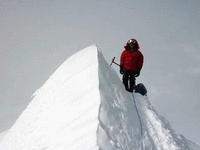 "It would be hard to put aside three weeks for Denali for the speed record," Matt said.
"It would be hard to put aside three weeks for Denali for the speed record," Matt said.
For Matt, the 50 in 50 goal was another adventure that helped raise awareness and money for Pulmonary Arterial Hypertension. Matt has taken up the cause because his best friend, Ian Hess, has PAH. Last summer, the Monizes climbed 14 Colorado fourteeners in eight days for the same purpose.
"After we did 14 fourteeners, we wanted to do something bigger to raise awareness," Matt said. "And not just in Colorado, in the whole United States."
Mike said this experience was different than the 14 fourteeners.
"With the 50 in 50, as much as anything, it was a cultural experience for us," he said. "We heard everything from local politics to environmental issues. It was great."
In addition to flying, Mike and Matt made a 12,000-mile loop by van -- nearly half the driving distance covered by the last group to attempt this, Mike said. Volunteers from the University of Colorado, Colorado State University, and Joel Gratz, a Boulder meteorologist who became the trip's weather man, drove them state-to-state, nearly around the clock.
In the northeast, they did six high points in one day. Mike said they often snoozed in between in the van.
Mike started climbing when he was a student at CU in the 1980s. Matt's enthusiasm for climbing -- sparked by a trek to Everest Base Camp -- has rekindled his, he said.
"Matt got me re-energized in mountaineering, in the alpinist world."
Matt also serves as an ambassador for Outdoor Nation, which focuses on getting kids outdoors. Mike said he likes for the family to include community service in their climbing.
Matt wasn't sure what they'll do next summer.
"We're thinking about next year taking a little bit of a break, slowing it down a little bit, maybe doing some individual rock and ice climbs," he said.
"Maybe not do any big expeditions for a while."
By Jenn Fields fields@coloradodaily.com
